
























At University Hospitals, we take our commitment to our community seriously and are grateful for your ongoing support in this rapidly changing world. Together, we’ll continue to treat patients like family, find new treatments and cures, and prepare the next generation of caregivers. Join others who are helping advance the science of health and the art of compassion by leaving their legacy.
To learn more, contact our Gift Planning Team: UHGiving.org/giftplanning | 216-983-2200
JACK, JOSEPH AND MORTON MANDEL CONCERT HALL AT SEVERANCE MUSIC CENTER
PAGE 5
INTRODUCTION
PAGE 7
Harding Conducts Schumann
Daniel Harding, conductor
Symphony No. 92 in G major, “Oxford” (page 8) by Franz Joseph Haydn
Sinfonia No. 2 (page 12) by George Walker
Symphony No. 2 in C major, Op. 61 (page 16) by Robert Schumann
Conductor biography (page 21)
PAGE 31
TCO SPOTLIGHT
Feature articles, musician interviews & season calendar
PAGE 43
IN THE NEWS
Noteworthy happenings at The Cleveland Orchestra
PAGE 48
SNAPSHOTS
Photo highlights from recent Cleveland Orchestra events
PAGE 54
THANK YOU
The community of supporters who bring the music to life











The New Grove Dictionary of Music and Musicians opens its entry for “symphony” with the following simple definition: “A term now normally taken to signify an extended work for orchestra.” Though its meaning and function have shifted over the centuries — one common variation is, somewhat confusingly, synonymous with “symphony orchestra” — this general definition has remained relatively stable since the late 18th century.
After Beethoven’s nine contributions to the genre, the symphony has come to be viewed by many musicians, scholars, and listeners as the pinnacle of Western art music composition. This weekend’s program, conducted by Daniel Harding, offers three different and wildly varied approaches to this time-tested form.
Thursday and Saturday’s concerts open with Franz Joseph Haydn’s “Oxford” Symphony. Dubbed the “Father of the Symphony,” Haydn is credited with solidifying the genre into its most well-known structure — that of a work for a large group of instruments split into four movements of contrasting tempos, keys, and moods. Like his other symphonies (106 in total), the “Oxford” is chock full of “Haydnisms” that gracefully bridge the gap between formal invention and charming wit.
We then jump 200 years into the future with George Walker’s Sinfonia No. 2, composed in 1990. From its first notes, the musical language sounds undeniably modern, but the structure is based on a much older “prototype” of the symphony — the “sinfonia,” a three-part orchestral work that often served as a curtain raiser for Italian operas in the 17th and 18th centuries. Walker would compose five sinfonias before his death in 2018, each a remarkable world unto itself.
Wrapping up the program is a symphony from between Haydn’s and Walker’s time periods: Robert Schumann’s Second. Composed in Dresden (above) between 1845 and 1846, the work takes the composer’s innate gift for melody — heard in so many of his songs — and casts it onto a large symphonic canvas. The dark turns in the first three movements point to Schumann’s poor state of health during its composition, though the work ultimately concludes with a brilliant, sun-kissed finale. — Kevin McBrien

Thursday, October 3, 2024, at 8 PM
Friday, October 4, 2024, at 11 AM
Saturday, October 5, 2024, at 8 PM
Franz Joseph Haydn (1732–1809)
Concert Preview with Eric Charnofsky
Thursday & Saturday: Reinberger Chamber Hall
Friday: Mandel Concert Hall one hour prior to performance
George Walker (1922–2018)
Symphony No. 92 in G major, 30 minutes “Oxford” *
I. Adagio — Allegro spiritoso
II. Adagio cantabile
III. Menuetto: Allegretto
IV. Presto
Sinfonia No. 2
I. ♩ = 76
II. Lamentoso e quasi senza misura. ♪ = 63
III. ♪ = 116
INTERMISSION
Robert Schumann (1810–1856)
15 minutes
20 minutes
Symphony No. 2 in C major, Op. 61 40 minutes
I. Sostenuto assai — Allegro ma non troppo
II. Scherzo: Allegro vivace
III. Adagio expressivo
IV. Allegro molto vivace
Total approximate running time: 1 hour 45 minutes
Thank you for silencing your electronic devices.
* Haydn’s Symphony No. 92 does not appear on Friday’s program, which will be performed without intermission.
by Franz Joseph Haydn
BORN : March 31, 1732, in Rohrau, Austria
DIED : May 31, 1809, in Vienna
▶ COMPOSED: 1789
▶ WORLD PREMIERE : The symphony was likely premiered in 1789, as part of the Concerts de la Loge Olympique in Paris, but there is no clear evidence of this. The first performance for which we have definite proof was on July 7, 1791, at Oxford University, under the composer’s direction.
▶ CLEVELAND ORCHESTRA PREMIERE : February 2, 1928, conducted by Music Director Nikolai Sokoloff
▶ ORCHESTRATION : flute, 2 oboes, 2 bassoons, 2 horns, 2 trumpets, timpani, and strings
▶ DURATION : about 30 minutes
THE AWARDING of honorary degrees is a centuries-old practice, but while it is still common to honor a recipient for work accomplished, it is no longer customary to demand from the candidate a “dissertation.” Were this to be done today, we might find ourselves enriched by an occasional musical masterpiece. (Brahms’s Academic Festival Overture, for instance, was a result of the composer’s honorary doctorate from the University of Breslau in 1879).
Franz Joseph Haydn had been proposed for an honorary degree from Oxford University by Charles Burney, a prominent music historian of the time. The ceremony took place on Friday,
July 8, 1791, and Haydn relates that he had to wear his resplendent gown of cerise and cream-colored silk for the rest of his three-day stay there, even while conducting. (He admitted in private that he felt “rather silly” in the doctoral robe.) He was proud of his degree, though, and told his biographer that he owed to it “much, I might say everything, in England. …”
The work that Haydn composed as his “dissertation” was not, as expected, the “Oxford” Symphony, but a complex

canon on the text “Thy voice, O Harmony, is divine.” Earlier in the week, in advance of his installation, three successive concerts were given, during each of which a new Haydn symphony was performed. On July 6, the composer arrived too late for the morning rehearsal, so another work — a G-major symphony composed in 1789 and unknown in England — was rehearsed, revised slightly (trumpets and timpani were added), and performed in the second concert on July 7. It thus became known as the “Oxford” Symphony.
The opening Adagio is extraordinarily gracious. Haydn supposedly had to spend considerable rehearsal time on the three opening chords. Not only are the harmonic extensions extremely beautiful, but one characteristic of the entire symphony appears at once: the pause. Long before Bruckner’s Second Symphony, here was a true “Symphony
of Pauses,” music in which the rests begin to speak, the silences become eloquent.
To musicologist Donald Francis Tovey, the fast section begins “as if butter would melt in its mouth.” However sharp the ensuing contrasts may appear, it is clear that Haydn is concerned with creating a tight and unified structure that would give every appearance of freedom. Note how important the octave leap in the main theme becomes, both melodically and rhythmically.
The slow movement gives us the fruit of Haydn’s serene, yet still ingenious side. With keenest skill, he varies the simple three-part form by introducing into the center section a phrase hinted at in the long-breathed main theme, expanding it into a theme of its own, and then building an exquisite woodwind coda on it after a beautifully altered return of the opening.

Haydn is often simultaneously called the “Father of the Symphony” and the “Father of the String Quartet” for his innovations in both genres. This painting by Julius Schmid imagines the composer directing a group of musicians in a chamber music rehearsal.

In the Menuetto, the composer gambles with the pause more daringly than elsewhere: at one point, he demands an extra full measure of silence. The prize of the movement, however, is the Trio — music of astounding originality. The horns and bassoons commence
The finale begins with one of the most delightful of all Haydn’s themes. … Nobody can say quite how often this theme recurs; the orchestra itself gets into heated argument as to how the tune really goes, and the doubts generally arise from the third bar onwards. A daddy-long-legs of a second
The finale is one of those inimitable creations by which Haydn likes to confound music scholars, music of scintillating wit and effortless workmanship.
with a syncopation and across-thebarline accent that produce a hilarious “three-legged” dance.
The finale is one of those inimitable creations by which Haydn likes to confound music scholars, music of scintillating wit and effortless workmanship. One would be unjust to withhold Tovey’s brief description of what happens, from his Essays in Musical Analysis:
subject sprawls affably into the discussion. … It is impossible to describe Haydn’s themes … without feeling irresponsible; but the life his themes live is one that has no room for meanness or triviality.
— adapted from a note by Klaus G. Roy Writer, composer, critic, and educator Klaus G. Roy was The Cleveland Orchestra’s program editor and annotator from 1957 to 1988. He received the Orchestra’s Distinguished Service Award in 2005.
by George Walker
BORN : June 27, 1922, in Washington, DC
DIED : August 23, 2018, in Montclair, New Jersey
▶ COMPOSED: 1990
▶ WORLD PREMIERE : April 15, 1993, with Neeme Järvi conducting the Detroit Symphony Orchestra
▶ This weekend’s performances mark the first presentations of Walker’s Sinfonia No. 2 by The Cleveland Orchestra.
▶ ORCHESTRATION : 2 flutes, piccolo, 2 oboes, English horn, 2 clarinets, bass clarinet, 2 bassoons, contrabassoon, 4 horns, 4 trumpets, 3 trombones, tuba, timpani, percussion (suspended cymbal, snare drum, bass drum, glockenspiel, xylophone, vibraphone, chimes), piano, harp, guitar, and strings
▶ DURATION : about 15 minutes
“MANY ORCHESTRAS THINK that a Black audience will only come for music with overtly African elements,” composer George Walker stated in a 2004 interview for the Detroit Free Press. “I find this view offensive. The most important thing is to select music of the highest quality that will have something to say to the audience.”
Walker, 82 at the time of the interview, never lacked something to say in his music, and over time, opportunities for audiences to hear his works have grown more frequent. From his first major composition, the First String Quartet of 1946 to Lilacs — the 1996 orchestral work that made him the first Black composer to win the Pulitzer Prize for
Music — and beyond, he forged and refined a canon of distinction. Even when he referenced or incorporated folkloric, gospel, or jazz sources, Walker’s voice is one of uncompromising originality.
Born in Washington, DC, in 1922, Walker began his training as a pianist during childhood and later pursued studies at Oberlin College and Conservatory, the Eastman School of Music, and the Curtis Institute of Music. Prominent teachers included pianists Robert Casadesus, Clifford Curzon, and Rudolf Serkin. He began composing at Curtis


as a graduate student and, while attending the American Conservatory in Fontainebleau as a Fulbright Scholar, refined his training with Nadia Boulanger, the most influential composition teacher of the 20th century.
Walker pursued a career as a concert pianist but focused on composition as well. He absorbed aspects of serialism and neoclassicism without embracing a particular dogma or school. His mostperformed work, Lyric for Strings (1946), is pastoral and inviting, akin to popular works by Copland and Barber — and, like Barber’s ubiquitous Adagio, the work
Though Walker focused most of his career on composition, he began his musical studies as pianist. Among his teachers were Robert Casadesus and Rudolf Serkin, both of whom performed and made recordings with The Cleveland Orchestra.
originated as the slow movement of a string quartet. (The two men had a teacher in common, Rosario Scalero.)
Walker’s mature style would be a jagged, muscular idiom, one that bears similarities to Hindemith and Stravinsky while sounding like neither — or much like anyone else. By the time Walker composed his Sinfonia No. 1 in 1984, his cerebral yet visceral stamp was well-established.
Walker’s Sinfonia No. 2 was commissioned by the Koussevitzky Music Foundation in the Library of Congress, named in honor of the longtime music director of the Boston Symphony Orchestra and devoted to the promotion of living composers. The Library received the manuscript in 1990, and the work was first performed by the Detroit Symphony Orchestra in 1993, conducted by Neeme Järvi.
What Walker produced for the occasion is a taut three-movement composition roughly 15 minutes in length. The first movement opens with an enigmatic theme akin to Shostakovich at his
most ambiguous, the music lapping in waves as it builds to a brassy proclamation. A transitional section works its way through the strings, from low to high, building toward a new motif on oboe. A tranquil passage punctuated with cello pizzicatos and shimmering harp leads to another brassy exertion before the ambiguity of the opening returns, ahead of a ruminative coda.
pianist and composer Ethan Iverson, said that he had never met Ellington, a fellow Washington, DC native, but the two men were aware of one another’s work and in certain compositions, Walker quoted Ellington outright.
Despite a contrasting section marked by chiming percussion and inquisitive woodwind statements, a sensation of urgent motion and barely checked
Even when he referenced or incorporated folkloric, gospel, or jazz sources, Walker’s voice
is one of uncompromising originality.
The work’s second movement, among Walker’s most uncanny creations, is marked Lamentoso e quasi senza misura — in essence, “mournful and nearly without measure.” Walker assigns the first half of the movement to a sinuous, meandering solo for unaccompanied flute, akin to Debussy’s Syrinx, adding an eerie chord for cellos and brittle figures on an acoustic guitar.
A curling motto on English horn and bass clarinet introduces the third movement, a bustling sequence of competing mottos over steadier, more assertive rhythms. In the brassy figures over firm bass lines, a listener might discern the stamp of big-band jazz à la Duke Ellington, albeit abstracted. Walker, in a 2013 interview with jazz
In 2022, The Cleveland Orchestra and Music Director Franz Welser-Möst released an album dedicated entirely to the music of George Walker, including two of his five sinfonias. Visit clevelandorchestra.com/recordings or The Cleveland Orchestra Store to listen or purchase.
energy — “foot-tapping insistence,” in Walker’s terms — rarely abates throughout the third movement. Density mounts throughout the work’s final pages, leading to a conclusion as grand as it is succinct.
— Steve Smith
Steve Smith is a journalist, critic, and editor based in New York City. He has written about music for The New York Times and The New Yorker, and served as an editor for the Boston Globe, Time Out New York, and NPR.

by Robert Schumann
BORN : June 8, 1810, in Zwickau, Saxony
DIED : July 29, 1856, in Bonn
▶ COMPOSED: 1845–46
▶ WORLD PREMIERE : November 5, 1846, with Felix Mendelssohn conducting the Leipzig Gewandhaus Orchestra
▶ CLEVELAND ORCHESTRA PREMIERE : October 20, 1932, conducted by Music Director Nikolai Sokoloff
▶ ORCHESTRATION : 2 flutes, 2 oboes, 2 clarinets, 2 bassoons, 2 horns, 2 trumpets, 3 trombones, timpani, and strings
▶ DURATION : about 40 minutes
THE SECOND SYMPHONY was written as Robert Schumann was recovering from a serious nervous breakdown suffered after a long concert tour to Russia the composer had undertaken in 1844 with his wife, the great pianist and composer Clara Schumann. The tour was a triumph for Clara, but Robert’s “nervous fever” was debilitating for a good part of the Russian journey. His ailments — whose symptoms included dizziness, anxiety, and hallucinations — continued through much of 1845 and ’46.
The health crisis was possibly linked to what must have seemed overwhelming artistic challenges in Schumann’s career. The composer, who had spent his early years writing exclusively for solo piano, was striving to establish himself in large-scale forms. In the symphonic
realm in particular, he felt that, despite the accomplishments of his “Symphony Year” of 1841 (which had produced the First Symphony and the first version of what is now known as the Fourth), he had yet to write a work to match in grandeur Schubert’s “Great” C-major Symphony. (Schumann had discovered the manuscript of that symphony in Vienna and had boundless admiration for it.) In an effort to concentrate on composition, Schumann relinquished the editorship of the music journal Neue Zeitschrift für Musik, of which he had also been the chief music critic. At first, however, this only gave him a sense

of loss that was not helped by his relocation from Leipzig to Dresden in fall 1844.
Schumann enjoyed a respite from his ailments in December 1845. It was during this period of Aufschwung (to borrow the title of a famous youthful piano piece, which translates approximately as “upward swing”) that he began the Second Symphony, though the orchestration and the revision of the score took up the better part of 1846, amidst some more ups and downs in the composer’s state of health. Schumann himself felt that the difficulties experienced before and during composition had an impact on the work; he wrote to D.G. Otten, the music director in Hamburg, in 1849:
I wrote my symphony in December 1845, and I sometimes fear my semi-invalid state can be divined from the music. I began to feel more myself when I wrote the last movement, and was certainly much better when I finished the whole work. All the same it reminds me of dark days.
The work has had a rather curious reception history. The first reviews after the premiere were enthusiastic. Both Brahms and Tchaikovsky considered the symphony the high point of Schumann’s output, and musicologist Philipp Spitta, writing in 1883, saw Schumann’s Second as the closest to Beethoven in “its bold decisiveness of form and overpowering wealth of expression.” Later, however, critics started finding fault with the symphony for what they perceived as formal incoherence, and the work was relatively
neglected for decades. Only in the last 50 years or so has the music world fully “rehabilitated” this symphony.
One way of understanding this symphony would be to view it as a struggle between the forces of light and darkness. The two opposing forces are present from the symphony’s opening measures, where a fanfare motif in the brass is set against mysterious chromatic figures in the strings. Transformations of both motifs dominate the entire first movement. Though the “light” fanfares seem to have the last word at the end of the first movement, they will briefly reappear in the second and third movements.
The “dark” chromaticism returns at the beginning of the second-movement Scherzo which, for all its briskness and dynamism, has been aptly described by British author Brian Schlotel as “pervaded by a mood of restlessness and uncertainty.” The Scherzo has two trios; the first moves in a light-footed triplet motion led by the woodwinds, the second is a chorale for strings, in which one may recognize the first germs of the last movement’s final melody, the ultimate goal of the symphony’s progress.
The Adagio espressivo is one of Schumann’s most profound slow movements. In it, echoes of Bach are combined with some personal touches, including an unusually subtle orchestration. Schumann wrote in his letter to Otten: “That my melancholy bassoon in the Adagio, written into that place with special affection, did not escape you gave me the greatest pleasure.” First intoned

by the strings, the main theme is soon taken over by the “melancholy bassoon” and an equally melancholy oboe. After
Schumann’s Second Symphony premiered at the Leipzig Gewandhaus, seen here in this 1836 painting by Felix Mendelssohn (who would conduct the premiere of Schumann’s work 10 years later). The musical excerpt below the painting is from Luigi Cherubini’s opera Ali Baba.
this formal transformation is part of its meaning.” The opening suggests a cheerful movement with a spirited melody that returns after an episode of equally bright character. Then, about halfway through the movement, we reach three solemn C-minor chords followed by general rests. Schumann quickly introduces a new theme, one that will gradually evolve into a quote from Beethoven’s song cycle To the Distant Beloved, which he had already used prominently in his Fantasy in C major (Op. 17) from 1836.
One way of understanding this symphony would be to view it as a struggle between the forces of light and darkness. The two opposing forces are present from the symphony’s opening measures. ...
a short fugal interlude, the main melody returns. Although the tempo is slow to begin with, there is a further ritardando (slowing down) near the end, and the final chords are marked molto Adagio.
Musicologist Anthony Newcomb has written of the finale: “[It] starts as one thing and becomes another, and
This time, the melody becomes the triumphant conclusion of the symphony; the ending is made even more grandiose by the spectacular timpani solo in the last measures.
— Peter Laki
Peter Laki is a musicologist and frequent lecturer on classical music. He is a visiting associate professor of music at Bard College.

Daniel Harding is the music and artistic director of the Swedish Radio Symphony Orchestra. Previously, he was music director of the Orchestre de Paris (2016–19) and principal guest conductor of the London Symphony Orchestra (2007–17). He is honored with the lifetime title of conductor laureate of the Mahler Chamber Orchestra, with whom he has worked for over 20 years. Harding recently took up the position of music director of the Youth Music Culture The Greater Bay Area (YMCG) and also began his tenure as music director of the Orchestra and Chorus of the Academia Nazionale di Santa Cecilia. Harding is a regular visitor to the world’s foremost orchestras, including the Wiener Philharmoniker, Royal Concertgebouw Orchestra, The Cleveland Orchestra, Los Angeles Philharmonic, and Chicago Symphony Orchestra, among others. He is also closely associated with the Aix-en-Provence Festival, where he has conducted new productions of Don Giovanni, The Turn of the Screw, La traviata, and Eugene Onegin. Harding’s sizeable discography includes Britten’s Billy Budd with the London Symphony Orchestra (winner of a Grammy Award for Best Opera Recording), works by Lutosławski with Solveig Kringelborn and the Norwegian

Chamber Orchestra, and Beethoven’s Violin Concerto with Frank Peter Zimmermann and the Berliner Philharmoniker. A regular collaborator with Harmonia Mundi, his latest recordings with the Swedish Radio Symphony Orchestra include The Wagner Project with Matthias Goerne, Mahler’s Fifth and Ninth symphonies, and Brahms’s Ein Deutsches Requiem.
In 2002, Harding was awarded the title Chevalier de l’Ordre des Arts et des Lettres by the French government and in 2017, was nominated to the position of Officier Arts et Lettres. He was elected a member of The Royal Swedish Academy of Music in 2012 and was awarded a CBE in the 2021 New Year Honours. Additionally, Harding is a qualified airline pilot.
The Cleveland Orchestra has been inviting composer-conductors to Severance for decades — Maurice Ravel, Béla Bartók (right), and Igor Stravinsky among them. However, when they first came to Cleveland to present their own music, they ventured into “new and uncharted” territory and were met with some resistance from audiences and critics alike. Explore these famous figures and their early appearances with the Orchestra in this special exhibit.
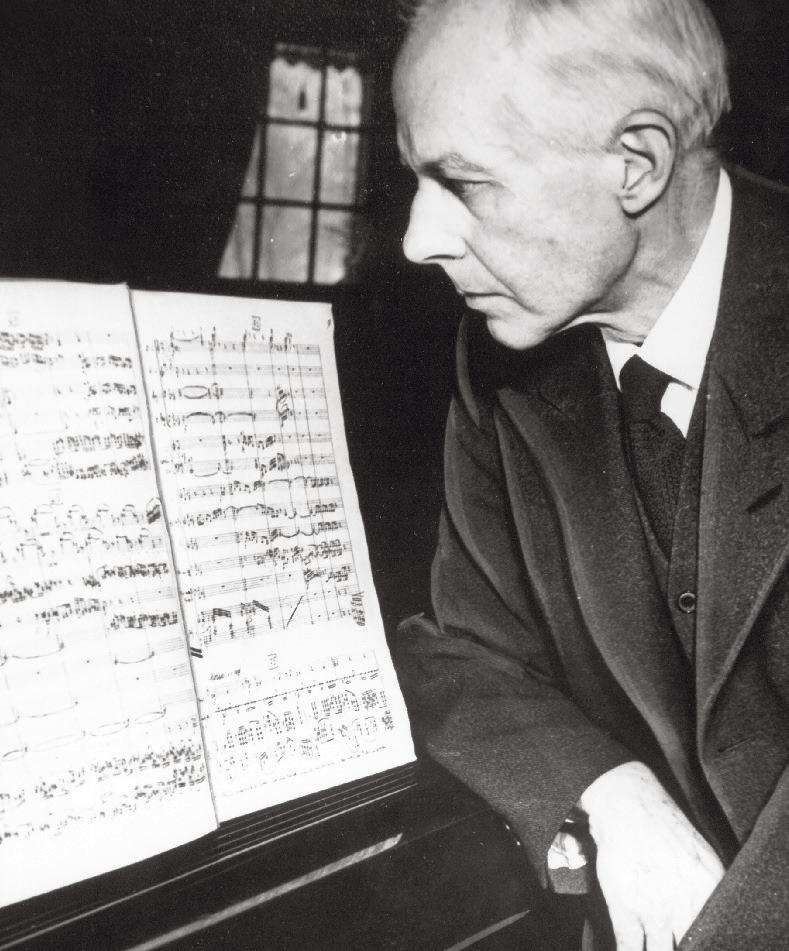

THE MAGICBOX
outside the Grand Foyer
Explore our latest audio recordings with Music Director Franz Welser-Möst. The MagicBox offers a quick digital look at these releases and includes rehearsal footage from select recording sessions.
Take a photographic journey into the inner workings of Severance Music Center, including where musicians gather before concerts, where tour equipment is stored, and where the air for the organ comes from.












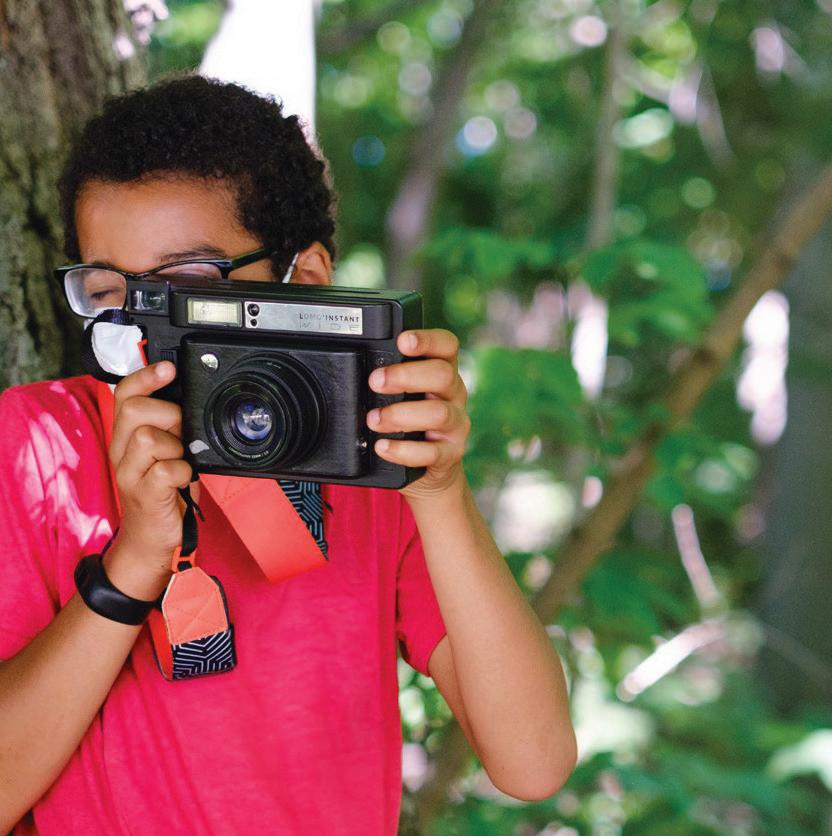


NOW FIRMLY IN ITS SECOND CENTURY , The Cleveland Orchestra, under the leadership of Franz Welser-Möst since 2002, is one of the most sought-after performing ensembles in the world. Year after year, the ensemble exemplifies extraordinary artistic excellence, creative programming, and community engagement. In recent years, The New York Times has called Cleveland “the best in America” for its virtuosity, elegance of sound, variety of color, and chamber-like musical cohesion.
Founded by Adella Prentiss Hughes, the Orchestra performed its inaugural concert in December 1918. By the middle of the century, decades of growth and sustained support had turned the ensemble into one of the most admired around the world.
The past decade has seen an increasing number of young people attending concerts, bringing fresh attention to The Cleveland Orchestra’s legendary sound and committed programming. More recently, the Orchestra launched several bold digital projects, including the streaming platform Adella.live and its own recording label. Together, they have captured the Orchestra’s unique artistry and the musical achievements of the Welser-Möst and Cleveland Orchestra partnership.
The 2024 – 25 season marks Franz Welser-Möst’s 23rd year as Music Director, a period in which The Cleveland


Orchestra has earned unprecedented acclaim around the world, including a series of residencies at the Musikverein in Vienna, the first of its kind by an American orchestra, and a number of celebrated opera presentations.
Since 1918, seven music directors — Nikolai Sokoloff, Artur Rodziński, Erich Leinsdorf, George Szell, Lorin Maazel, Christoph von Dohnányi, and Franz Welser-Möst — have guided and shaped the ensemble’s growth and sound. Through concerts at home and on tour, broadcasts, and a catalog of acclaimed recordings, The Cleveland Orchestra is heard today by a growing group of fans around the world.

FIRST VIOLINS
Liyuan Xie
FIRST ASSOCIATE CONCERTMASTER
Virginia M. Lindseth, PhD, Chair
Jung-Min Amy Lee
ASSOCIATE CONCERTMASTER
Gretchen D. and Ward Smith Chair
Stephen Tavani
ASSISTANT CONCERTMASTER
Dr. Ronald H. Krasney Chair
Wei-Fang Gu
Drs. Paul M. and Renate H. Duchesneau Chair
Kim Gomez
Elizabeth and Leslie Kondorossy Chair
Chul-In Park
Harriet T. and David L. Simon Chair
Miho Hashizume
Theodore Rautenberg Chair
Jeanne Preucil Rose
Larry J.B. and Barbara S.
Robinson Chair
Alicia Koelz
Oswald and Phyllis Lerner
Gilroy Chair
Yu Yuan
Patty and John Collinson Chair
Isabel Trautwein
Trevor and Jennie Jones Chair
Katherine Bormann
Analisé Denise Handke
Gladys B. Goetz Chair
Zhan Shu
Youngji Kim
Genevieve Smelser
SECOND VIOLINS
Stephen Rose*
Alfred M. and Clara T. Rankin Chair
Jason Yu2
James and Donna Reid Chair
Eli Matthews1
Patricia M. Kozerefski and Richard J. Bogomolny Chair
Sonja Braaten Molloy
Carolyn Gadiel Warner
Elayna Duitman
Ioana Missits
Jeffrey Zehngut
Sae Shiragami
Kathleen Collins
Beth Woodside
Emma Shook
Dr. Jeanette Grasselli Brown and Dr. Glenn R. Brown Chair
Yun-Ting Lee
Jiah Chung Chapdelaine
Gawon Kim
Wesley Collins*
Chaillé H. and Richard B.
Tullis Chair
Stanley Konopka2
Mark Jackobs
Jean Wall Bennett Chair
Lisa Boyko
Richard and Nancy Sneed Chair
Richard Waugh
Lembi Veskimets
The Morgan Sisters Chair
Eliesha Nelson
Anthony and Diane Wynshaw-Boris Chair
Joanna Patterson Zakany
William Bender
Thomas Lauria and Christopher Lauria Chair
Gareth Zehngut
CELLOS
Mark Kosower*
Louis D. Beaumont Chair
Richard Weiss1
The GAR Foundation Chair
Charles Bernard2
Helen Weil Ross Chair
Bryan Dumm
Muriel and Noah Butkin Chair
Tanya Ell
Thomas J. and Judith Fay
Gruber Chair
Ralph Curry
Brian Thornton
William P. Blair III Chair
David Alan Harrell
Martha Baldwin
Dane Johansen
Paul Kushious
Maximilian Dimoff*
Clarence T. Reinberger Chair
Derek Zadinsky2
Charles Paul1
Mary E. and F. Joseph Callahan Chair
Mark Atherton
Thomas Sperl
Henry Peyrebrune
Charles Barr Memorial Chair
Charles Carleton
Scott Dixon
HARP
Trina Struble*
Alice Chalifoux Chair
FLUTES
Joshua Smith*
Elizabeth M. and William C.
Treuhaft Chair
Saeran St. Christopher
Jessica Sindell2
Austin B. and Ellen W. Chinn Chair
Mary Kay Fink
PICCOLO
Mary Kay Fink
Anne M. and M. Roger Clapp Chair
OBOES
Frank Rosenwein*
Edith S. Taplin Chair
Corbin Stair
Sharon and Yoash Wiener Chair
Jeffrey Rathbun2
Everett D. and Eugenia S. McCurdy Chair
Robert Walters
ENGLISH HORN
Robert Walters
Samuel C. and Bernette K.
Jaffe Chair
CLARINETS
Afendi Yusuf*
Robert Marcellus Chair
Robert Woolfrey
Victoire G. and Alfred M. Rankin, Jr. Chair
Daniel McKelway2
Robert R. and Vilma L. Kohn Chair
Amy Zoloto
E-FLAT CLARINET
Daniel McKelway
Stanley L. and Eloise M.
Morgan Chair
BASS CLARINET
Amy Zoloto
Myrna and James Spira Chair
BASSOONS
John Clouser*
Louise Harkness Ingalls Chair
Gareth Thomas
Jonathan Sherwin
CONTRABASSOON
Jonathan Sherwin
HORNS
Nathaniel Silberschlag*
George Szell Memorial Chair
Michael Mayhew§
Knight Foundation Chair
Jesse McCormick
Robert B. Benyo Chair
Hans Clebsch
Richard King
Meghan Guegold Hege

TRUMPETS
Michael Sachs*
Robert and Eunice Podis
Weiskopf Chair
Jack Sutte
Lyle Steelman2
James P. and Dolores D. Storer Chair
Michael Miller
CORNETS
Michael Sachs*
Mary Elizabeth and G. Robert Klein Chair
Michael Miller
Brian Wendel*
Gilbert W. and Louise I. Humphrey Chair
Richard Stout
Alexander and Marianna C. McAfee Chair
Shachar Israel2
BASS TROMBONE
Luke Sieve
EUPHONIUM & BASS TRUMPET
Richard Stout
TUBA
Yasuhito Sugiyama*
Nathalie C. Spence and Nathalie S. Boswell Chair
TIMPANI vacant
PERCUSSION
Marc Damoulakis*
Margaret Allen Ireland Chair
Thomas Sherwood
Tanner Tanyeri
KEYBOARD INSTRUMENTS
Carolyn Gadiel Warner
Marjory and Marc L. Swartzbaugh Chair
LIBRARIANS
Michael Ferraguto
Joe and Marlene Toot Chair
Donald Miller
Gabrielle Petek
ENDOWED CHAIRS CURRENTLY UNOCCUPIED
Elizabeth Ring and William Gwinn Mather Chair
Blossom-Lee Chair
Clara G. and George P. Bickford Chair
Sandra L. Haslinger Chair
Paul and Lucille Jones Chair
Charles M. and Janet G. Kimball Chair
Sunshine Chair
Otto G. and Corinne T. Voss Chair
Mr. and Mrs. Richard K. Smucker Chair
Rudolf Serkin Chair
CONDUCTORS
Christoph von Dohnányi
MUSIC DIRECTOR LAUREATE
Daniel Reith
ASSOCIATE CONDUCTOR
Sidney and Doris Dworkin Chair
Lisa Wong
DIRECTOR OF CHORUSES
Frances P. and Chester C. Bolton Chair
* Principal
§ Associate Principal
1 First Assistant Principal
2 Assistant Principal
This roster lists full-time members of The Cleveland Orchestra. The number and seating of musicians onstage varies depending on the piece being performed. Seating within the string sections rotates on a periodic basis.























































“It’s
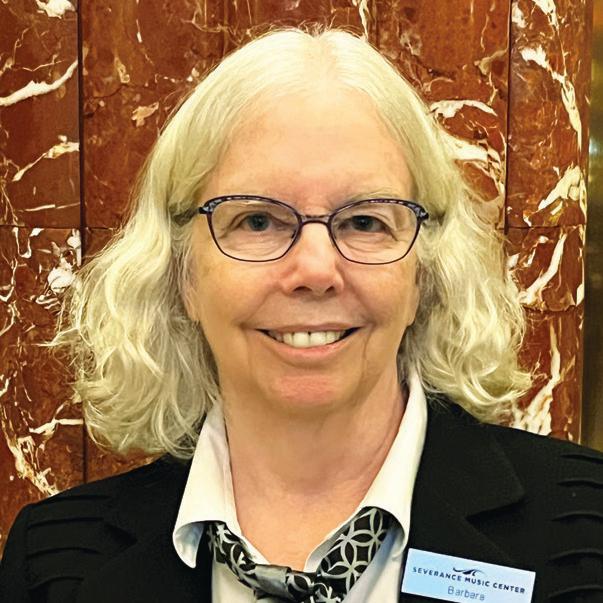
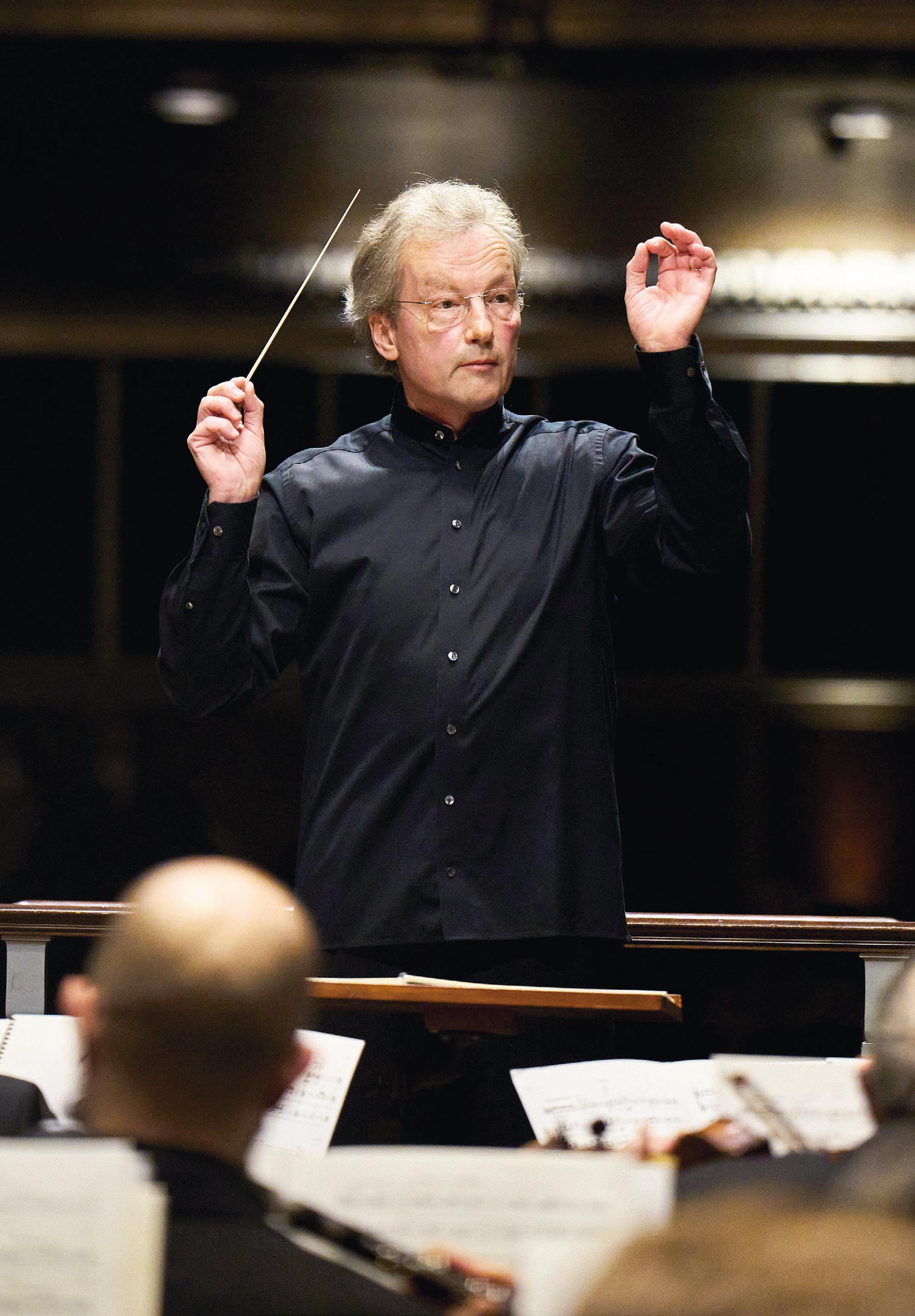
Music Director
KELVIN SMITH FAMILY CHAIR
As we embark on our 2024 – 25 season, Music Director Franz Welser-Möst is poised to lead a series of concerts that promise to captivate and inspire. We recently caught up with him to discuss the season’s most anticipated performances, his longstanding collaborations with renowned artists, and the stories and vision guiding his programming decisions this year.
Looking ahead to our 23rd season together is like being a kid in a candy store! Which program would you highlight as particularly special to you?
FRANZ : One program that stands out to me is the one where we perform Mahler’s Das Lied von der Erde [November 21–23]. The Orchestra and I haven’t played that piece in over 16 years — it’s been a long time coming. Mahler’s later works, especially this one, are profound and mind-boggling in their reflections on life and farewells. It’s a piece that has a special place in my heart.
Your choice of the tenor-baritone version for Das Lied is interesting, especially since the tenor-alto version is more commonly performed. What drove that decision?
FRANZ : It’s really strange — I think it’s a deeply personal choice. The male voice in this piece has always resonated with me on an emotional level. I think it has to do with my first exposure to Das Lied, which was through a recording of baritone Hermann Prey singing it. I listened to it often as a child, and that experience has stayed with me throughout my life. The tenor-baritone version brings a certain gravitas and intimacy that I find particularly compelling, and I’m looking forward to performing it with Limmie [Pulliam] and Iurii [Samoilov] this fall.
The Beethoven piano concerto cycle with Igor Levit is obviously another major highlight this season [November 6–17]. How do you approach preparing for such an extensive cycle compared to your usual concert weeks? ▶ ▶ ▶

▶
FRANZ : The preparation isn’t very different from my end, but it’s certainly a marathon for the soloist. For Igor, it’s more intense — each concerto demands a different mindset and emotional investment. But he’s one of the most exceptional pianists in the world today and is more than up to the challenge. For the Orchestra, it’s all about maintaining consistency and energy across multiple performances. Frankly, this cycle is going to be much more stressful for Igor than it will be for us!
You’ll also be performing a special program with Lithuanian soprano
Asmik Grigorian [March 13 & 15, 2025] before we leave for Carnegie Hall. Can you tell us more about your collaboration with her and this unique program?
FRANZ : Asmik is an extraordinary artist, one of those rare talents who appears maybe once every 50 years. I’m not exaggerating. We’ve worked together on several opera productions, and her intensity on stage is something to
behold. I’ve heard some people say they haven’t experienced such intensity since Maria Callas. Our concert with her will feature Richard Strauss’s Four Last Songs. Asmik has sung the Four Last Songs many times, and she brings a unique depth to them. But I felt that wasn’t enough to truly showcase her talent, so I suggested we also perform the final scene from Puccini’s Suor Angelica, which is incredibly powerful and will leave the audience deeply moved. I seriously expect some weeping at the end of the program!
With such diverse repertoire, how do you navigate the demands of these works and the need to keep the performances engaging for both the musicians and the audience?
FRANZ : It’s about finding the right emotional balance and pacing. With works like Das Lied and the Four Last Songs, for example, there’s a need for
introspection and emotional depth. But it’s equally important to ensure that each performance feels fresh and spontaneous. That’s where the relationship between conductor and orchestra becomes crucial. Our musicians and I have worked together for many years, and there’s a deep level of trust and understanding. This allows us to explore new nuances in the music, even in pieces we’ve performed many times before.
Speaking of long-standing relationships, you’ve worked with many great musicians throughout your career. How does your approach differ when collaborating with a new artist compared to someone you’ve worked with for years?
FRANZ : The first time you work with someone, there’s always an element of discovery. You’re learning about each other’s musical instincts and finding a common language. But when you’ve worked with someone over many years, there’s a deep, almost unspoken understanding that develops. It allows you to go further in your interpretations, to take risks, and to explore the music in new ways.
With Asmik, for example, we’ve developed a very close musical relationship over several years, starting with our collaboration on Salome in Salzburg in 2018. That production was a turning point for her career, and it was a
privilege to be part of that journey with her. When you have that kind of connection, it brings a special energy to the performance.
One last question: Which concerts this season, outside of the ones you are leading, are you most looking forward to as an audience member?
FRANZ : That’s always a tough one! But I’m particularly interested in the Tan Dun concert with Marc Damoulakis [October 31 & November 2]. Tan Dun’s music is incredibly innovative, and Marc is such a creative and skilled player. It’s going to be fascinating to see how they bring this unique Water Concerto to life.
I also think Thomas Adès’s program [February 20 & 22, 2025] is beautifully structured. America: A Prophecy is such a great piece. And there’s something about living composers conducting their own works that makes such programs very special.


THE ARTS OF COMPOSING and conducting emphasize opposite ends of the personality spectrum: the former tends to be an intensely private activity associated with the solitude of the studio, while the latter relies on the extrovert’s affinity for communicating with the public. Yet both can converge in the same artist.
This season, The Cleveland Orchestra is showcasing three stellar exemplars of the phenomenon. Esa-Pekka Salonen ascends the podium on October 10, 12, and 13, while Tan Dun makes his Cleveland conducting debut a few weeks later, on October 31 and November 2. And on February 20 and 22, 2025, Thomas Adès, returns to lead the Orchestra in a major new commission.
All three artists are leading figures in
the international classical music scene. Naturally, each brings unique “insider” knowledge when it comes to conducting their own music. But their insights into the creative process will likewise illuminate the works by other composers that they have selected for their respective programs.
Far from a novelty, the combination of composer-conductor roles was commonplace before the increasing complexity of professional musical life began to favor specialization. The Cleveland Orchestra’s own past includes numerous composer-conductors who made the trip to Cleveland to work with its fabled musicians. Maurice Ravel stopped by on his first American tour in 1928 — though Nikolai Sokoloff, the Orchestra’s first music director, complained that
his conducting was “both messy and ghastly” — while Igor Stravinsky began his association with the Orchestra in 1925. After leading a program of his works in 1955, he declared: “I am really a happy man batoning this fine group.”
Esa-Pekka Salonen initially envisioned a life devoted wholeheartedly to composition. But in 1983, at age 25, he impressed the music world when he filled in at the last minute for Michael Tilson Thomas to conduct the Philharmonia Orchestra in Mahler’s Third Symphony. To his own surprise, he thereby launched one of the preeminent conducting careers of our era.
After a decade or so spent immersing himself in the music of others as a conductor, Salonen recalled, he came to understand that “there is more than one truth,” compositionally speaking: it was not monopolized by the avant-garde European language in which he had been trained. That epiphany led to a creative breakthrough and a new focus on his work as a composer.
Salonen, now 66, has channeled some of his most innovative ideas as a composer through the age-old concerto format. Along with Ravel’s Le Tombeau de Couperin and Sibelius’s Fifth Symphony, Salonen’s Cleveland program will feature his expansive Cello Concerto, which was premiered in 2017. Originally written for Yo-Yo Ma, it will introduce Cleveland audiences to the remarkable young Finnish cellist Senja Rummukainen.
Yo-Yo Ma, as it happens, was featured on the soundtrack of Crouching Tiger, Hidden Dragon, the Ang Lee film from 2000, for which Tan Dun’s music won both an Oscar and a Grammy Award. Born in a village in Hunan Province in 1957 and an émigré to New York, Tan Dun has become known for his imaginative fusions of Chinese and Western musical traditions.

A gripping theatricality and sense of ritual imbue many of Tan Dun’s works, which frequently incorporate musical ideas inspired by natural elements. He will conduct two of his own compositions that manifest these traits. With his 1998 Water Concerto, which calls for the soloist — in this performance, Cleveland’s Principal Percussionist Marc Damoulakis — to manipulate basins filled with water, Tan Dun writes that he hopes to encourage the audience to “listen and rediscover life’s elements, things that are around us but we don’t notice.” His 2012 Concerto for Orchestra draws on his earlier opera, Marco Polo, about the legendary Italian traveler of the Silk Road.

The unique sound world that Tan Dun has developed gives him an unparalleled perspective on Britten’s Four Sea Interludes, which similarly originate from an opera, his landmark Peter Grimes. An early Stravinsky piece, Fireworks, will pay homage to still more elements as the concert’s dazzling opener.
Thomas Adès, born in London in 1971, made his conducting debut with The Cleveland Orchestra in spring 2023. For his return engagement, Adès has revised his millennial work America: A Prophecy. An apocalyptic meditation setting Mayan poetry and other texts, this newly expanded version of the piece was co-commissioned by the Orchestra and features The Cleveland Orchestra Chorus alongside mezzo-soprano Kelley O’Connor. Adès will juxtapose his music with the infrequently played Orchestral Set No. 2 by Charles Ives and a pair of sea-related works by Sibelius and the late Kaija Saariaho. When asked about performing the music of others, Adès responded, “The score is just a map of intentions. … The music came before the score. And the music is the thing behind the surface.” With this season’s stellar lineup of composer-conductors, we can fully expect each to illuminate the music beneath the score in the intriguing programs they have constructed. — Thomas May
Thomas May is a writer, critic, educator, and translator. A regular contributor to The New York Times, The Seattle Times, Gramophone, and Strings magazine, he is the English-language editor for the Lucerne Festival.

MARGARET ALLEN IRELAND CHAIR
Later this fall, Severance Music Center will be filled with sounds quite unusual for a concert hall — that of water dripping, splashing, and bubbling. Rest assured, a pipe has not burst in the basement! Rather, these sounds will be an integral part of Tan Dun’s 1998 Water Concerto, conducted by the Academy–Award winning composer-conductor on October 31 and November 1. We recently sat down with Principal Percussionist Marc Damoulakis to learn about performing this unique work and the preparations involved.
Will this be your first solo venture with the Orchestra?
MARC : I performed John Corigliano’s Conjurer concerto during Covid, which was my first solo appearance with the Orchestra. We were distanced, since it’s for strings and percussion only, and it was recorded for Adella.
How did you come across Tan Dun’s Water Concerto? Have you known about it for a long time, or was this a recent discovery?
MARC : It was written for my teacher, Christopher Lamb, and commissioned by the New York Philharmonic. I heard him play it in Boston in 2001 while I was in the New World Symphony and was absolutely taken by it. As percussion concertos go, it’s a fascinating one and I thought it would be great to give it a shot someday.
Was this also your first exposure to Tan Dun’s music?
MARC : He wrote a concerto for cello and percussion quartet that I played as a student, so I was familiar with him and his music. I didn’t realize he did film scores until Crouching Tiger, Hidden Dragon was released, which is probably the opposite for most people. I knew him first as a concert composer!
This is an incredibly unique piece in terms of the setup and instruments required. Describe a bit about what that entails. What does your preparation look like? ▶ ▶ ▶
MARC : Finding and sourcing this stuff has taken tons and tons of hours. The soloist has two large acrylic hemispheres that are filled with water, miked, and placed on stands that are lit from beneath. Each member of the percussion section also has one of these bowls. As far as sounds go, there’s water dripping, plucking, splashing, bubbling. There are wooden bowls that are flipped upside down, float on the surface, and act as drums, alongside other cylinders, cups, and tubes that manipulate the water. Tan Dun calls for an instrument called the waterphone — this steel resonator that’s filled with water that can be bowed or drummed — which looks and sounds amazing. There are also some traditional instruments like gongs, bells, and vibraphone. So, it’s been really challenging to explore all these sounds. It’s like learning a completely different language.
Looking through the score, it seems like there’s some flexibility to put your own spin on the work. Do you feel that when you’ve been preparing it?
MARC : Yes, I do! There’s room for creativity and improvisation as well. The piece also has a theatrical element, but it comes honestly. It embodies the element of water. Tan Dun has taken something that’s so familiar to everybody and isolated it, putting it under a microscope. It’s an entirely original way to say something.

How would you tell someone who’s not familiar with the piece or Tan Dun’s music what to listen for? How would you recommend they go into this experience?
MARC : I would say just enjoy the experience. It’s a unique piece and utterly different than anything else. On one level, it stays true to a lot of what we percussionists do, engineering sounds and playing grooves, yet here, these are displaced on instruments that are completely one-of-a-kind.
Should people in the front row bring a poncho? I’m sure you’ll be wearing something that can get splashed!
MARC : Oh gosh … Hopefully not! There are many interpretations of this piece, and some span the spectrum of how crazy they get. Tan Dun dedicated the concerto to Tōru Takemitsu, so in my mind, that evokes more of a quiet garden rather than wild splashing. But we’ll see what happens!





OCT 10, 12 & 13
SALONEN CONDUCTS
SALONEN
Esa-Pekka Salonen, conductor
Senja Rummukainen, cello
RAVEL Le Tombeau de Couperin
ESA-PEKKA SALONEN Cello Concerto
SIBELIUS Symphony No. 5
OCT 17–19
MAHLER’S THIRD SYMPHONY
Klaus Mäkelä, conductor
Jennifer Johnston, mezzo-soprano
The Cleveland Orchestra Chorus
The Cleveland Orchestra Children’s Chorus
MAHLER Symphony No. 3
OCT 31 & NOV 2
TAN DUN CONDUCTS
TAN DUN
Tan Dun, conductor
Marc Damoulakis, percussion
STRAVINSKY Fireworks
TAN DUN Water Concerto
BRITTEN Four Sea Interludes from Peter Grimes
TAN DUN Concerto for Orchestra
NOV 6 & 7
BEETHOVEN PIANO CONCERTO CYCLE PROGRAM 1
Franz Welser-Möst, conductor
Igor Levit, piano
Augustin Hadelich, violin
Julia Hagen, cello
BEETHOVEN Triple Concerto
BEETHOVEN Piano Concerto No. 3
NOV 9 & 12
BEETHOVEN PIANO CONCERTO CYCLE PROGRAM 2
Franz Welser-Möst, conductor
Igor Levit, piano
BEETHOVEN Piano Concerto No. 2
BEETHOVEN Piano Concerto No. 4
NOV 15–17
BEETHOVEN PIANO CONCERTO CYCLE PROGRAM 3
Franz Welser-Möst, conductor
Igor Levit, piano
BEETHOVEN Piano Concerto No. 1
BEETHOVEN Piano Concerto No. 5, “Emperor”
NOV 21–23
MAHLER’S SONG OF THE EARTH
Franz Welser-Möst, conductor
Limmie Pulliam, tenor
Iurii Samoilov, baritone
The Cleveland Orchestra Chorus
BERND RICHARD DEUTSCH Urworte
MAHLER Das Lied von der Erde
NOV 29–DEC 1
RHAPSODY IN BLUE
David Robertson, conductor
Marc-André Hamelin, piano
COPLAND Suite from Appalachian Spring
GERSHWIN Rhapsody in Blue ELLINGTON New World A-Comin’
COPLAND Suite from The Tender Land
RECITAL
DEC 4
GERSTEIN IN RECITAL
Kirill Gerstein, piano
R. SCHUMANN Carnaval
FRANCISCO COLL Waltzes Toward Civilization
RAVEL La valse (trans. for piano)
LISZT Bénédiction de Dieu dans la solitude
LISZT Piano Sonata in B minor
DEC 5–7
AX PLAYS MOZART
Pablo Heras-Casado, conductor
Emanuel Ax, piano
MOZART Piano Concerto No. 20
SHOSTAKOVICH Symphony No. 10
JAN 9, 11 & 12
AN AMERICAN IN PARIS
Stéphane Denève, conductor
Steven Banks, saxophone
MILHAUD La création du monde
GUILLAUME CONNESSON A Kind of Trane
POULENC Suite from Les biches
GERSHWIN An American in Paris
JAN 16–18
HAHN PLAYS BRAHMS
Elim Chan, conductor
Hilary Hahn, violin
BRAHMS Violin Concerto
LUTOSŁAWSKI Concerto for Orchestra
FEB 7–9
ALSO SPRACH
ZARATHUSTRA
Thomas Guggeis, conductor
Mark Kosower, cello
R. STRAUSS Also sprach Zarathustra
DUTILLEUX Tout un monde lointain...
RAVEL La valse
FEB 13 & 15
BRUCKNER’S SEVENTH
Fabio Luisi, conductor
Tim Mead, countertenor
SILVIA COLASANTI Time’s Cruel Hand
BRUCKNER Symphony No. 7
FEB 20 & 22
ADÈS CONDUCTS ADÈS
Thomas Adès, conductor
Kelley O’Connor, mezzo-soprano
The Cleveland Orchestra Chorus
SIBELIUS The Oceanides
SAARIAHO Oltra Mar
THOMAS ADÈS America: A Prophecy IVES Orchestral Set No. 2
RECITAL
FEB 23
ÓLAFSSON & WANG IN RECITAL
Víkingur Ólafsson, piano
Yuja Wang, piano
BERIO Wasserklavier
SCHUBERT Fantasie in F minor
LIGETI Bewegung (Movement) from Three Pieces for Two Pianos
BRUBECK Fugue from Points on Jazz
NANCARROW Study No. 6 (arr. Adès)
JOHN ADAMS Hallelujah Junction
ARVO PÄRT Hymn to a Great City RACHMANINOFF Symphonic Dances
FEB 27–MAR 1
BEETHOVEN’S EROICA
Alan Gilbert, conductor
Leonidas Kavakos, violin
SHOSTAKOVICH Violin Concerto No. 2
BEETHOVEN Symphony No. 3, “Eroica”
MAR 6–9
TCHAIKOVSKY’S FOURTH SYMPHONY
Franz Welser-Möst, conductor
Seong-Jin Cho, piano
RAVEL Rapsodie espagnole
RAVEL Piano Concerto in G major
TCHAIKOVSKY Symphony No. 4
MAR 13 & 15
HAYDN & STRAUSS
Franz Welser-Möst, conductor
Asmik Grigorian, soprano
HAYDN Symphony No. 52
R. STRAUSS Four Last Songs
JANÁČEK Suite from From the House of the Dead
PUCCINI Final Scene from Suor Angelica
MAR 14
PROKOFIEV’S FOURTH SYMPHONY
Franz Welser-Möst, conductor
HAYDN Symphony No. 52
PROKOFIEV Symphony No. 4
RECITAL
MAR 27
ANDSNES IN RECITAL
Leif Ove Andsnes, piano
GRIEG Piano Sonata
TVEITT Piano Sonata No. 29, “Sonata Etere”
CHOPIN 24 Preludes
APR 17–19
BACH’S EASTER ORATORIO
Bernard Labadie, conductor
Joélle Harvey, soprano
Adèle Charvet, mezzo-soprano
Andrew Haji, tenor
Gordon Bintner, bass-baritone
The Cleveland Orchestra Chorus
J.S. BACH Easter Oratorio
J.S. BACH Sinfonia from Cantata No. 29
J.S. BACH Magnificat
APR 24–26
MOZART & ELGAR
Kazuki Yamada, conductor
Francesco Piemontesi, piano
MOZART Piano Concerto No. 25
ELGAR Symphony No. 1
RECITAL
MAY 7
KISSIN IN RECITAL
Evgeny Kissin, piano
BEETHOVEN Piano Sonata No. 7
CHOPIN Nocturne in G minor, Op. 15, No. 3
CHOPIN Nocturne in E-flat major, Op. 55, No. 2
CHOPIN Nocturne in E minor, Op. posth. 72, No. 1
CHOPIN Polonaise in A major, Op. 40, No. 1, “Military”
SHOSTAKOVICH Piano Sonata No. 2
SHOSTAKOVICH Prelude and Fugue in F-sharp minor
SHOSTAKOVICH Prelude and Fugue in D-flat major
SHOSTAKOVICH Prelude and Fugue in D minor
MAY 8–10
MOZART’S SYMPHONY NO. 40
Franz Welser-Möst, conductor
MOZART Symphony No. 40
ALLISON LOGGINS-HULL
New Work
PROKOFIEV Symphony No. 3 *
MAY 17, 22 & 25
JANÁČEK’S JENŮFA
Franz Welser-Möst, conductor
Latonia Moore, soprano
Pavol Breslik, tenor
Miles Mykkanen, tenor
Nina Stemme, soprano
The Cleveland Orchestra Chorus
JANÁČEK Jenůfa
Opera presentation sung in Czech with projected supertitles
MAY 23 & 24
VOX HUMANA
Franz Welser-Möst, conductor
Sarah Aristidou, soprano
Tony Sias, narrator
The Cleveland Orchestra Chorus
POULENC La voix humaine
J.S. BACH Concerto from Komm, Jesu, komm
USTVOLSKAYA Symphony No. 5, “Amen”
J.S. BACH Aria from Komm, Jesu, komm
R. STRAUSS Symphonic Fantasy on Die Frau ohne Schatten
* Not performed on the Friday matinee concert
Generous support for the 2024–25 Recital Series provided by the Reyzis Family Foundation

ON AUGUST 23 , The Cleveland Orchestra and Music Director Franz Welser-Möst departed on a two-week tour of Europe, featuring eight concerts in six venues across five countries. This occasion marked the Orchestra’s 80th international tour in its 107-year history.
Kicking off the tour was an ambitious concert at the Berlin Philharmonie. Presented as part of the genre-defying Berlin MusikFest, the Orchestra performed works by John Adams and Prokofiev alongside the European premiere of Can You See? by Daniel R. Lewis Composer Fellow Allison Loggins-Hull.
The second leg of the tour was particularly notable, marking The Cleveland Orchestra’s return to Finland for the first time since 1965. In the first of two concerts at Helsinki’s Musiikkitalo, pianist Víkingur Ólafsson joined the Orchestra for Schumann’s Piano Concerto. Enthusiastic ovations greeted the ensemble both nights, leading one critic to exclaim, “One hopes that [the Orche-
stra’s] next visit to Finland is to take place without another sixty-year hiatus.”
Three days later, Tchaikovsky’s Fifth Symphony — and the Liebestod from Wagner’s Tristan und Isolde as an encore — capped a program at the KKL during the Lucerne Festival, one of the Orchestra’s frequent and much-loved stopping places.
A concert on September 4 marked another special occasion: the 200th birthday of Anton Bruckner. To kick off Brucknerfest Linz 2024, the Orchestra performed the composer’s Fourth Symphony in his hometown of Ansfelden, mere steps away from where he was born — a truly once-in-a-lifetime opportunity.
Near the end of the tour, the Orchestra enjoyed a brief yet welcome excursion to Bratislava’s Reduta Hall — another city it had not performed in since 1965 — before two final concerts at Vienna’s Musikverein, where the Orchestra has enjoyed a regular residency since 2003.
Though the Orchestra has seen many international tours over the years, this one in particular — with its mix of destinations both familiar and less familiar — made it a tour to remember.


2024 IS A GREAT TIME to be a fan of Anton Bruckner. This year marks the 200th anniversary of the Austrian composer’s birth, and The Cleveland Orchestra has been commemorating the occasion in several ways.
On August 16, the Orchestra released a new audio recording of Bruckner’s Symphony No. 4, led by Music Director Franz Wesler-Möst. This marks The Cleveland Orchestra’s third audio release of 2024, following Sergei Prokofiev’s Symphony No. 6 and an album featuring works by Béla Bartók. The recording is available for digital streaming and download in spatial audio on all major platforms.
Several days later, a new video production of the symphony was released on the Orchestra’s digital streaming
platform, Adella.live, featuring an interview with Welser-Möst. Both this and the audio recording were recorded live at Severance in March 2024.
These releases preceded the Orchestra’s recent tour of Europe with WelserMöst, which included two performances of Bruckner’s Fourth in Austria. The first was part of a concert given in Ansfelden, the composer’s hometown, on his birthday, September 4.
“Bruckner’s music was deeply rooted in the traditions of his homeland, but in many ways, his compositions were far ahead of his time,” Welser-Möst said before the tour. “This may be one of the reasons why his music has not lost its appeal. It inspires audiences through a profound listening experience.”
Visit clevelandorchestra.com/recordings and adella.live for more information.
Franz Welser-Möst discusses the artistry behind Bruckner’s Fourth Symphony preceding a performance of the work on Adella.live.


THIS SUMMER , Assistant Principal Bassoon Barrick Stees stepped down after 23 years of performances with The Cleveland Orchestra.
Alongside concerts at Severance, Blossom, and on tour, Stees frequently played chamber music with his Cleveland colleagues. He most recently appeared alongside Cleveland Orchestra flutist Mary Kay Fink and members of the New World Symphony in Dai Fujikura’s Cosmic Breath, part of a chamber concert given during the Orchestra’s South Florida Residency in November 2023.
Stees taught bassoon at the Cleveland Institute of Music, Kent Blossom Music Festival, Michigan State University, and
Interlochen Center for the Arts, among others. Over the years, he played with the Hartford Symphony Orchestra (where he was previously principal bassoon), Pittsburgh Symphony Orchestra, and Los Angeles Philharmonic, and appeared at music festivals throughout North America, South America, and Europe. He was awarded the Presidential Scholar Teacher Recognition Award from the United States Secretary of Education.
Stees gave his final concert at Severance with The Cleveland Orchestra on July 25. After the performance of Dvořák’s Sixth Symphony, guest conductor Petr Popelka invited the bassoonist to the front of the stage for a solo bow, which was met with a rousing ovation from the audience and musicians.
Barrick Stees held the Sandra L. Haslinger Chair.
above: Barrick Stees after the Orchestra’s second Summers at Severance concert on July 25.
2024 HAS SEEN A WAVE of generosity from supporters of The Cleveland Orchestra, particularly through three major gifts from longtime patrons.
In August, the Orchestra announced a gift from the Kelvin and Eleanor Smith Foundation, funding the Kelvin Smith Family Chair currently held by Music Director Franz Welser-Möst for the rest of his tenure. The Foundation makes grants to nonprofit, charitable organizations around Cleveland that adhere to excellence in their missions, creativity in approach, fiscal responsibility, and dynamic leadership in their service to the community.
said, “I want to express my gratitude to the Smith Foundation for this gift. Now in the 23rd year of my partnership with The Cleveland Orchestra, I am astounded by the breadth and depth of what we have accomplished together.”
Earlier this year, longtime patrons and supporters Myrna and Jim Spira gave a special gift to support the Orchestra’s artistic programming, pension fund, and annual fund. The gift also endowed the Myrna and Jim Spira Bass Clarinet Chair, currently occupied by Amy Zoloto.
Jim Spira, a member of the Orchestra’s Board of Trustees since 2014, said, “It’s a privilege to be part of a community that has supported the development of an orchestra of this caliber in a city of this size. It’s a remarkable civic accomplishment.” President & CEO André Gremillet added to the sentiment: “This incredible gift is not only inspiring
It’s a privilege to be part of a community that has supported the development of an orchestra of this caliber in a city of this size. It’s a remarkable civic accomplishment.
— Jim Spira, Cleveland Orchestra Trustee
“The Smith Foundation wishes to applaud Franz Welser-Möst’s impactful leadership with a meaningful gift honoring his longstanding commitment to Cleveland,” said Ellen Stirn Mavec, president and chairman of the Foundation and granddaughter of the late Kelvin and Eleanor Smith. In response, Welser-Möst
but also essential in supporting our efforts to broaden and deepen relationships with Cleveland Orchestra audiences. This meaningful support also helps to ensure our sustainability and legacy for future generations.”
Another recently endowed musician chair came thanks to the generosity of

Tony and Diane Wynshaw-Boris, who established the Anthony and Diane Wynshaw-Boris Chair, currently occupied by violist Eliesha Nelson.
At a reception ceremony, the couple reflected on their decision to endow a viola chair. “I played viola when I was young,” Tony said. “And we have had several opportunities to hear what a wonderful musician [Eliesha] is when she played in community chamber concerts.” Diane commented further: “We have witnessed the efforts made by
the Orchestra and musicians to reach out and engage the entire Cleveland community, from schools to neighborhoods. We greatly appreciate and are proud of those efforts. [Tony and I] are honored and privileged to be able to endow a viola chair for Eliesha and do our small part to ensure that The Cleveland Orchestra maintains its excellence far into the future.”
right: 1) The centerpiece of the 2024 Jack, Joseph and Morton Mandel Opera & Humanities Festival was an imaginative production of Mozart’s The Magic Flute. Directed by Nikolaus Habjan and conducted by Music Director Franz Welser-Möst, it featured the singers performing alongside larger-than-life puppets (including a dramatic Queen of the Night, dazzlingly sung by Kathryn Lewek).
Other festival highlights included: 2) a performance by jazz trumpeter and composer Terence Blanchard, 3) a kidfriendly introduction to the opera — complete with activities in Smith Lobby — and 4) a panel discussion on diversity in classical music, moderated by (l-r) Jeremy Johnson and featuring Jessica Lee, Aaron Flagg, and Liza Grossman.
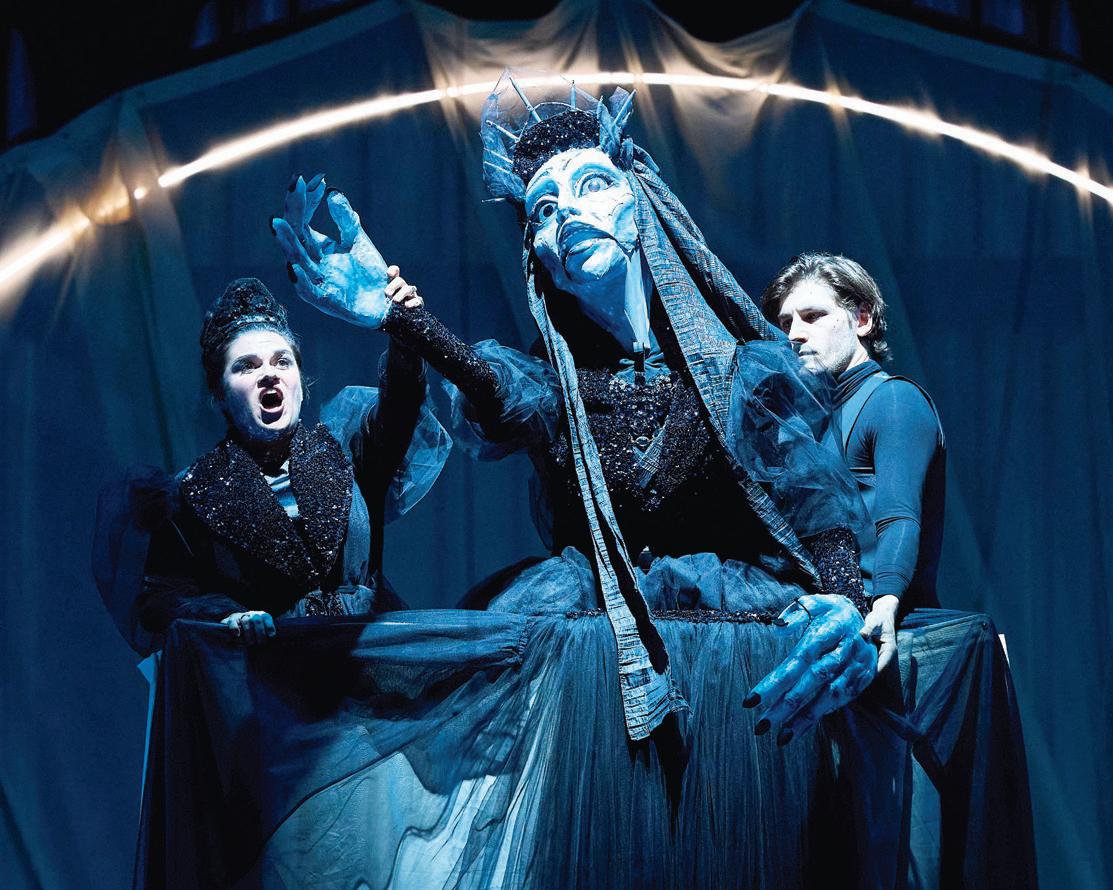







left: 5) Summertime in Northeast Ohio meant the start of the Blossom Music Festival and new opportunities to make memories with friends and family.
This season featured a fantastic lineup of classical gems, pops and Broadway favorites, and thrilling movies. 6) Superstar banjoist Béla Fleck jumpstarted Blossom’s classical concerts with his mesmerizing transcription of Gershwin’s Rhapsody in Blue, which turned 100 this year.
7) The season also featured two collaborations with the Blossom Festival Chorus: presentations of The Return of the King — the final film in Peter Jackson’s The Lord of the Rings trilogy — as well as a performance of Borodin’s Polovtsian Dances from Prince Igor, conducted by Domingo Hindoyan
FROM TOP LEFT:


above: The Cleveland Orchestra’s Education & Community department stayed busy this summer with several events in and around Cleveland.
1) Instrument “petting zoos” delighted our youngest fans at local summer festivals such as PRIDE in the CLE and Parade the Circle. 2) At Blossom on July 13, Hispanic Family Night brought people together for great food and great camaraderie.
3) The Cleveland Orchestra Youth Orchestra (COYO) ended their 2023–24 season with a special exchange with the Toronto Symphony Youth Orchestra, beginning with a joint concert at Blossom followed by a trip to Toronto to perform together at Roy Thomson Hall.
right: 4) After a brief hiatus, Summers at Severance returned with food and drinks on the front terrace followed by a concert in Mandel Concert Hall. The July 11 concert featured the Cleveland debut of conductor Oksana Lyniv and the Severance debut of pianist Inon Barnatan




below: 5) July 21 marked the annual Blossom Summer Soirée. Attendees were treated to a pre-concert reception with food and drinks, followed by a spectacular concert with Leslie Odom, Jr. and The Cleveland Orchestra. 6) Dressed in their summer best, (l-r) Peggy Koblenzer, Anne Dunn, Laura Milo, Katie Orendorf, and Tatiana Harris enjoy the evening’s festivities. 7) Hyun and Cathy Park smile for the camera during the reception held at Knight Grove at Blossom Music Center.

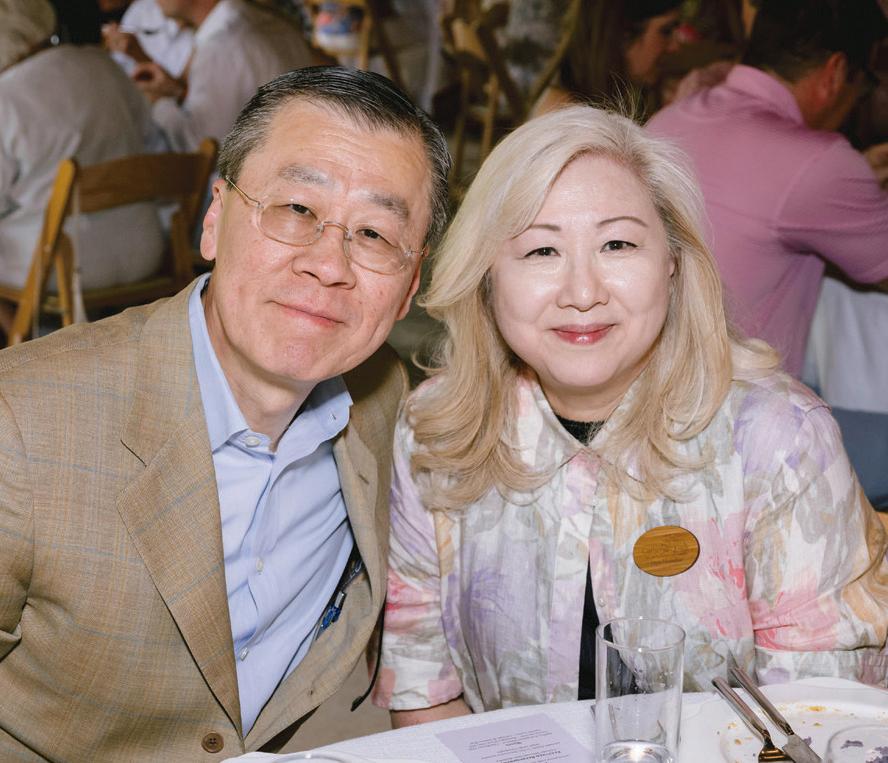
Why join the Members Club? PER MONTH $29
IT PAYS FOR ITSELF!
Pay just $10 for tickets regularly priced up to $105. Buy as few as 4 concerts per year and you’ll save over single ticket prices.
ULTIMATE FLEXIBILITY
Reserve the day-of or weeks before. It’s your choice.
GREAT SEATS ON DEMAND!
Choose your preferred section at Severance Music Center or Blossom Music Center, and we’ll reserve the best available seats for you.
20% OFF ADDITIONAL TICKETS
Share The Cleveland Orchestra with family and friends. You can now purchase extra tickets with the 20% off subscriber’s discount. SUBSCRIBE FOR JUST TICKETS! ACCESS TO OVER 100 CONCERTS PER YEAR! $10








We are deeply thankful for the generosity of every member of The Cleveland Orchestra family.
To learn more, visit clevelandorchestra.com/give
Adella Prentiss Hughes Society
Gifts of $1,000,000 and more
Mr. and Mrs.* Geoffrey Gund
Joan Y. Horvitz*
Anne H. and Tom H. Jenkins
Milton and Tamar Maltz
Mrs. Jane B. Nord
Mr. and Mrs.* Richard K. Smucker
Gifts of $200,000 to $999,999
The Musicians of The Cleveland Orchestra (in-kind contribution for community programs and opportunities to secure funding)
Art of Beauty Company, Inc.
Mary Freer Cannon*
Iris and Tom Harvie
Haslam 3 Foundation
Dr. and Mrs. Anthony T. Lauria
Mrs. Norma Lerner
Jan R. Lewis
Mr. and Mrs. Albert B. Ratner
Jenny and Tim Smucker
Anonymous
Gifts of $100,000 to $199,999
Gay Cull Addicott*
Mr. and Mrs.* Eugene J. Beer
Mr. Yuval Brisker
Rebecca Dunn
Dr. Michael Frank and Patricia A.* Snyder
Mr. and Mrs. Michael J. Horvitz
The Walter and Jean Kalberer Foundation
Dr. and Mrs. Herbert Kloiber (Europe)
Mr. and Mrs. Dennis W. LaBarre
Thomas E. Lauria (Miami)
Ms. Beth E. Mooney
Patrick and Milly Park
Ilana and Chuck Horowitz Ratner
James* and Donna Reid
Jim and Myrna Spira
Ms. Ginger Warner
Mrs. Jayne M. Zborowsky
Lillian Baldwin Society
Gifts of $75,000 to $99,999
Mr. and Mrs. Alexander M. Cutler
Dr. Hiroyuki and Mrs. Mikiko Fujita
Richard and Michelle Jeschelnig
Mr. and Mrs. Douglas A. Kern
Mr. and Mrs. Alfred M. Rankin, Jr. Anonymous
George Szell Society
Gifts of $50,000 to $74,999
Randall and Virginia Barbato
Brenda and Marshall B. Brown
Irad and Rebecca Carmi
JoAnn and Robert Glick
Ms. Alexandra Hanna
Mr. and Mrs. Donald M. Jack, Jr.*
Elizabeth B. Juliano
Richard and Christine Kramer
Nancy W. McCann
The Oatey Foundation (Cleveland, Miami)
William J. and Katherine T. O’Neill
Mrs. Alfred M. Rankin, Sr.
Mr. and Mrs. James A. Ratner
The Ralph and Luci Schey
Foundation
Astri Seidenfeld
The Seven Five Fund
Richard and Nancy Sneed
Dr. Russell A. Trusso
Mr. and Mrs. Franz Welser-Möst
Paul and Suzanne Westlake
Barbara and David Wolfort
Tony and Diane Wynshaw-Boris
Anonymous
Elisabeth DeWitt
Severance Society
Gifts of $25,000 to $49,999
Victor and Abby Alexander
Dr. and Mrs. Wolfgang Berndt (Europe)
Mr. William P. Blair III*
Robin Dunn Blossom
Jeanette Grasselli Brown and Glenn R. Brown*
Dr. Robert Brown and
Mrs. Janet Gans Brown
Dr. Thomas Brugger* and Dr. Sandra Russ
J. C. and Helen Rankin Butler
Jim and Mary Conway
Judith and George W. Diehl
Elliot and Judith Dworkin
Mary Jo Eaton (Miami)
Mr.* and Mrs. Bernard H. Eckstein
Drs. Wolfgang and Gabi Eder (Europe)
Dr. and Mrs. Robert Ehrlich (Europe)
Mrs. Connie M. Frankino
Mr. and Mrs. Robert W. Gillespie
David and Robin Gunning
Sondra and Steve Hardis
Mrs. Lynn Heisler
Amy and Stephen Hoffman
David and Nancy Hooker
Richard Horvitz and Erica Hartman-Horvitz (Cleveland, Miami)
Mrs. Marguerite B. Humphrey*
Allan V. Johnson
Mr. and Mrs. Joseph P. Keithley
Cynthia Knight
John D. and Giuliana C. Koch
Ms. Cathy Lincoln
Jon A. and Virginia M. Lindseth, PhD
Mr. Jeff Litwiller
Mr. and Mrs. Ben Mathews
Mr. Stephen McHale
Randy and Christine Myeroff
The Honorable John Doyle Ong
Catherine and Hyun Park
Mr. and Mrs. Benjamin N. Pyne
Mr. and Mrs. Ronald Ratner
James and Marguerite Rigby
Mr.* and Mrs. David A. Ruckman
Mark and Shelly Saltzman
Donna E. Shalala (Miami)
Hewitt and Paula Shaw
R. Thomas and Meg Harris Stanton
Mr.* and Mrs. Donald W. Strang, Jr.
Tom and Shirley* Waltermire
Anya Weaving and Tom Mihaljevic
Meredith and Michael Weil
Anonymous (2)
Dudley S. Blossom Society
Gifts of $15,000 to $24,999
Mr. James Babcock
Mr. and Mrs. Jules Belkin
Mr. and Mrs. C. Perry Blossom
Mr. and Mrs. Charles P. Bolton
Dr. Christopher P. Brandt and Dr. Beth Sersig
Mr. D. McGregor Brandt, Jr.
Dr. Ben H. and Julia Brouhard
Meghan and Trent Brown
Mr. and Mrs. Kevin C. Conway
Mary* and Bill Conway
Mrs. Barbara Cook
Mrs. Anita Cosgrove
Mr. and Mrs. Matthew V. Crawford
Maureen A. Doerner and Geoffrey T. White
Nancy and Richard Dotson
Mr. Brian L. Ewart and Mr. William McHenry
Mr. and Mrs. Richard C. Fedorovich
Friends of The Cleveland Orchestra
Richard and Ann Gridley
Mr. Calvin Griffith
Gary L. and Cari T. Gross
Mr. and Mrs. Harley I. Gross
Kathleen E. Hancock
Jack Harley and Judy Ernest
Gerald Hughes
Mr. and Mrs. Brinton L. Hyde
Sarah Liotta Johnston and Jeff Johnston
Rob and Laura Kochis
Eeva and Harri Kulovaara (Miami)
Mr. and Mrs. S. Ernest Kulp
Ms. Heather Lennox
Daniel R. Lewis (Miami)
In honor of Emma Skoff Lincoln
Linda Litton
Mr. and Mrs. Alex Machaskee
Alan Markowitz M.D. and Cathy Pollard
Ann Jones Morgan
Sally S. and John C. Morley*
Jennifer and Alexander Ogan
Dr. Roland S. Philip and Dr. Linda M. Sandhaus
Douglas and Noreen Powers
Mr. Winthrop Quigley and Ms. Bonnie Crusalis
Saul and Mary Sanders (Miami)
Rachel R. Schneider
Dr. and Mrs. James L. Sechler
Meredith M. Seikel
Robyn Shifrin
Mr. and Mrs. Richard P. Stovsky
Kathryn and Duncan Stuart
Dr. Elizabeth Swenson
Bruce and Virginia Taylor
Philip and Sarah Taylor
Mr. and Mrs. Alfred Umdasch (Europe)
Karen Walburn
Mr. Daniel and Mrs. Molly Walsh
Mr. and Mrs. Jeffery J. Weaver
Robert C. Weppler
Max and Beverly Zupon
Anonymous (3)
Frank H. Ginn Society
Gifts of $10,000 to $14,999
Dr. and Mrs. D. P. Agamanolis
Mr. and Mrs. A. Chace Anderson
Ms. Viia R. Beechler
Laura and Jon Bloomberg
Ted and Donna Connolly
Mr. and Mrs. Chester F. Crone
Mrs. Barbara Ann Davis
Giles Debenham
Dr.* and Mrs. Lloyd H. Ellis Jr.
Joan Alice Ford
Dr. Edward S. Godleski
Mr. Robert Goldberg
Mr. and Mrs. Michael Gröller (Europe)
Alfredo and Luz Maria Gutierrez (Miami)
Robin Hitchcock Hatch
Dr. Robert T. Heath and Dr. Elizabeth L. Buchanan
Dr. Fred A. Heupler
Ms. Mary Joe Hughes
Donna L. and Robert H. Jackson
Barbara and Michael J. Kaplan
Andrew and Katherine Kartalis
Jonathan and Tina Kislak (Miami)
David C. Lamb
Charles and
Josephine Robson Leamy*
Dr. Edith Lerner
Dr. David and Janice Leshner
Mr. Fredrick W. Martin
Mr.* and Mrs. Arch J. McCartney
Drs. Amy and James Merlino
Loretta J. Mester and George J. Mailath
Claudia Metz and Thomas Woodworth
Mr. William A. Minnich
Brian and Cindy Murphy
Deborah L. Neale
Mr. David A. Osage and Ms. Claudia C. Woods
Mr. J. William and Dr. Suzanne* Palmer
Julia and Larry Pollock
Ms. Rosella Puskas
Mr. and Mrs. Roger F. Rankin
Kim Russel and Dirk Brom
Dr. Isobel Rutherford
Dr. and Mrs.* Martin I. Saltzman
Patricia J. Sawvel
David M. and Betty Schneider
Kenneth Shafer
Rev. George Smiga
Roy Smith
Michalis and Alejandra Stavrinides
Ryan and Melissa Stenger
Mrs. Mary L. Sykora
Taras Szmagala and Helen Jarem
Dr. Gregory Videtic and Rev. Christopher McCann
Susanne Wamsler and Paul Singer (Europe)
Mr. and Mrs. Fred A. Watkins
Denise G. and Norman E. Wells, Jr.
Sandy and Ted Wiese
Sandy Wile and Sue Berlin
Katie and Donald Woodcock
Anonymous (6)
The 1929 Society
Gifts of $5,000 to $9,999
Mr. and Mrs. Todd C. Amsdell
Claudia Bacon
Robert and Dalia Baker
Thomas and Laura Barnard
Fred G. and Mary W. Behm
Deena and Jeff Bellman
Mel Berger and Jane Haylor
Mr. and Mrs. Lawrence R. Beyer
Marilyn and Jeffrey Bilsky
Dr. and Mrs. Eugene H. Blackstone
Doug and Barbara* Bletcher
Laurel Blossom
Jeff and Elaine Bomberger
Ms. Kristina E. Boykin
Mr. and Mrs. David* Briggs
Frank and Leslie Buck
William and Barbara Carson
Ms. Maria Cashy
Victor A. Ceicys M.D. and Mrs. Kathleen Browning Ceicys
Mr. and Mrs. James B. Chaney
Ellen Chesler and Matthew Mallow (Miami)
Drs. Wuu-Shung and Amy Chuang
Drs. Mark Cohen and Miriam Vishny
Ellen E.* and Victor J. Cohn
Kathleen A. Coleman
Diane Lynn Collier and Robert J. Gura
Marjorie Dickard Comella
Robert and Jean* Conrad
Mr. and Mrs. Manohar Daga
Mr.* and Mrs. Ralph Daugstrup
Allan and Connie Dechert
Pete and Margaret Dobbins
Henry and Mary* Doll
Michael Dunn
Carl Falb
Regis and Gayle Falinski
Bruce* and Nancy Fisher
Jan and John Fitts
Ms. Nancy Flogge
Mr. and Ms. Dale Freygang
Barbara and Peter* Galvin
Joy E. Garapic
Mr. James S. Gascoigne and Ms. Cynthia Prior
Anne* and Walter Ginn
Brenda and David Goldberg
Barbara H. Gordon
André and Ginette Gremillet
Nancy Hancock Griffith
Candy and Brent Grover
The Thomas J. and Judith Fay Gruber
Charitable Foundation
Nancy* and James Grunzweig
Ms. Marianne Gymer
Mr. Newman T. Halvorson, Jr.
Gary Hanson and Barbara Klante
Clark Harvey and Holly Selvaggi
Mr. and Mrs. Jonathan Hatch
Barbara L. Hawley and David S. Goodman
Matthew D. Healy and Richard S. Agnes
Dr. Toby Helfand
Anita and William Heller
Mr. and Mrs. Jerry Herschman
Mr. and Mrs. Martin R. Hoke
Dr. Keith A. and Mrs. Kathleen M. Hoover
James* and Claudia Hower
Phillip M. Hudson III (Miami)
Elisabeth Hugh
Mrs. Laura Hunsicker
David and Dianne Hunt
Richard and Jayne Janus
Reuben Jeffery (Miami)
Robert and Linda Jenkins
Mr. David and Mrs. Cheryl Jerome
Dr. Richard* and Roberta Katzman
Rod Keen and Denise Horstman
Howard and Michele Kessler
Joanne Kim and Jim Nash
Dr. and Mrs.* William S. Kiser
Audrey Knight
Mr. and Mrs.* S. Lee Kohrman
Dr. Ronald H. Krasney and Vicki Kennedy*
Douglas and Monica Kridler
Peter* and Cathy Kuhn
Mr. and Mrs.* Arthur J. Lafave, Jr.
Dr. and Mrs. John R. Lane
Dr.* and Mrs. Roger H. Langston
Kenneth M. Lapine and Rose E. Mills
John N.* and Edith K. Lauer
Young Sei Lee
Judith and Morton Q. Levin
Dr. Stephen B. and Mrs. Lillian S. Levine
Drs. Todd and Susan Locke
David and Janice* Logsdon
Joan C. Long
Caetano R. Lopes (Miami)
Anne R. and Kenneth E. Love
Richard and Terry Lubman (Miami)
Neil and Susan Luria
David Mann and Bernadette Pudis
Mr. Keith G. Marsh
Dr. Ernest and Mrs. Marian Marsolais
Mr. and Mrs. Bruce V. Mavec
James and Virginia Meil
Dr. Susan M. Merzweiler
Lynn and Mike Miller
Drs. Terry E. and Sara S. Miller
Curt and Sara Moll
Amy and Marc Morgenstern
Eudice M. Morse
Mr. Bert and Dr. Marjorie Moyar
Mr. and Mrs. Scott C. Mueller
Mr. Raymond M. Murphy
Mr. Christopher B. Nance and Ms. Jessica V. Colombi
Richard and Kathleen Nord
Mr. and Mrs. Forrest A. Norman III
Malinda and Robert Och
Thury O’Connor
Harvey* and Robin Oppmann
Richard Organ and Jamie Nash
Mr. Henry Ott-Hansen
Mr. and Mrs. Kenneth W. Outcalt
Chris and Susan Pappas
Eliot Pedrosa (Miami)
Alan and Charlene Perkins
Dr. Marc A. and Mrs. Carol Pohl
Mr. and Mrs. Frank Porter
Dr. and Mrs. John N. Posch
Mr. Robert and Mrs. Susan Price
Sylvia Profenna
Pysht Fund
Lute and Lynn Quintrell
Beth and Clay Rankin
Brian and Patricia Ratner
Mr. and Mrs.* Robert J. Reid
Ms. Julie Severance Robbins
Lisa Robinson and Robert Hansel
Amy and Ken Rogat
Robert* and Margo Roth
Dr. Adel S. Saada
Dr. Vernon E. Sackman and Ms. Marguerite Patton*
Mr. and Mrs.* James A. Saks
Richard Salomon and Laura Landro
Richard B. and Cheryl A. Schmitz
Ms. Beverly J. Schneider
Gary Schwartz and Constance Young
Sally and Larry Sears
Mr. Eric A. Seed and Ms. Ellen Oglesby
Deborah Sesek
Drs. Daniel and Ximena Sessler
Mr.* and Mrs. Michael Shames
Mr. Philip and Mrs. Michelle Sharp
Howard and Beth Simon
Mr. James S. Simon
The Shari Bierman Singer Family
Drs. Charles Kent Smith and Patricia Moore Smith
Mrs. Gretchen D. Smith
Sandra and Richey* Smith
Mr. and Mrs. William E. Spatz
George and Mary* Stark
Howard Stark M.D. and Rene Rodriguez (Miami)
Sue Starrett and Jerry Smith
AJ and Nancy Stokes
Ms. Lorraine S. Szabo
Robert and Carol Taller
Alan and Barbara Taylor
Mr. John R. Thorne and Family
Mr. and Mrs. Gary B. Tishkoff
Mr.* and Mrs. Robert N. Trombly
Drs. Anna* and Gilbert True
Steve and Christa Turnbull
Robert and Marti* Vagi
Bobbi and Peter* van Dijk
Mr. and Mrs. Les C. Vinney
Kenneth H. Kirtz*
Mr. Randall Wagner
Mr. and Mrs. Eric Wald
John and Jeanette Walton
Greg and Lynn Weekley
Mr. and Mrs. Mark Allen Weigand
Dr. Edward L. and Mrs. Suzanne Westbrook
Stephen Whyte and Rebecca Ralston
Dr. Paul R. and Catherine Williams
Ms. Linda L. Wilmot
Bob and Kat Wollyung
Mr. Graham Wood
Anonymous (3)
Composer’s Circle
Gifts of $2,500 to $4,999
Mr. Leonard H. Abrams*
Ms. Nancy A. Adams
Kristen and Matthew Alloway
Sarah May Anderson
Susan S. Angell
Chris Ansbacher
Ms. Bonnie M. Baker
Eric Barbato and Elisha Swindell
Ms. Katherine Barnes
Dr. James Bates
Mrs. Lois Robinson Beck
Drs. Nathan A.* and Sosamma J. Berger
Margo and Tom Bertin
Mitch and Liz Blair
Zeda W. Blau
Marilyn and Lawrence Blaustein
Ms. Pamela M. Blemaster
Blossom Friends of The Cleveland Orchestra
Mr. John and Mrs. Robyn Boebinger
Dr. and Mrs. Timothy Bohn
Mr. and Mrs. Richard H. Bole
David and Julie Borsani
Ms. Ellen Botnick
Dr. David Bowers
Lisa and Ronald Boyko
Adam and Vikki Briggs
Matthew D. Brocone
Mr. and Mrs. Dale R. Brogan
Dale and Wendy Brott
Bennett Brown
Mrs. Frances Buchholzer
Mr. Gregory and Mrs. Susan Bulone
James Burke
Mr. and Mrs. Robert G. Busha
Mr. and Mrs. William D. Buss II
Mr. William Busta and Joan Tomkins
Dr. and Mrs. William E. Cappaert
Peter and Joanna Carfagna
Mr. and Mrs. John J. Carney
Dr. Ronald Chapnick* and Mrs. Sonia Chapnick
Mr. and Mrs. Kerry Chelm
Gregory and Kathrine Chemnitz
Gertrude Kalnow Chisholm and Homer D.W. Chisholm
Mr. and Mrs. Edward A. Chuhna
Robert and Judy Ciulla
Pete Clapham and Anita Stoll
Jill and Paul Clark
Richard J. and Joanne Clark
Dr. William and Dottie Clark
Drs. John and Mary Clough
Mr. John Couriel and Dr. Rebecca Toonkel (Miami)
Laura Cox
Drs. Kenneth and Linda Cummings
Karen and Jim Dakin
Dr. and Mrs. Thomas M. Daniel
Jeffrey Dean and Barbara and Karen Claas
Mr. Douglas Dever
Michael and Amy Diamant
Dr. and Mrs. Howard Dickey-White
Mr. and Mrs. David C. Dillemuth
Do Unto Others Trust (Miami)
Carl Dodge
Jack and Elaine Drage
Mr. and Mrs. Robert Dreshfield
Mr. Barry Dunaway and Mr. Peter McDermott
Bill Durham (Miami)
Ms. Mary Lynn Durham
Mr. and Mrs. Robert P. Duvin
Mr. and Mrs. Ronald E. Dziedzicki
Peter and Sandy Earl
Erich Eichhorn and Ursel Dougherty
S. Stuart Eilers
Peter and Kathryn Eloff
Andy and Leigh Fabens
Mr. and Mrs. Frederick A. Fellowes
Anne Ferguson and Peter Drench
Mr. William and Dr. Elizabeth Fesler
Mr. and Mrs. Mark Filippell
Nancy M. Fischer
Mr. Dean Fisher
Joan and Philip Fracassa
Mr. and Mrs. Larry Frankel
Howard Freedman and Rita Montlack
Mr. William Gaskill and Ms. Kathleen Burke
Mr. and Mrs. M. Lee Gibson
Daniel and Kathleen Gisser
Holly and Fred Glock
Dr.* and Mrs. Victor M. Goldberg
Pamela G. Goodell
Ms. Aggie Goss
Mr. Robert Goss
Dr. and Mrs. Ronald L. Gould
Bob Graf and Mia Zaper
Mr. James Graham and Mr. David Dusek
Drs. Erik and Ellen Gregorie
Mr. Morgan Griffiths
Mr. Davin and Mrs. Jo Ann Gustafson
Mr. Ian S. Haberman
Mary Louise Hahn
Dr. James O. Hall
Megan Hall and James Janning
Mr. and Mrs. David P. Handke, Jr.
Jane Hargraft and Elly Winer
Mr. Samuel D. Harris
Lilli and Seth* Harris
In Memory of Hazel Helgesen
Drs. Gene and Sharon Henderson
T. K.* and Faye A. Heston
Mr. and Mrs. Arnold Hirshon
Mr. and Mrs. Stephen J. Holler
Thomas and Mary Holmes
Charles M. Hoppel and Marianne Karwowski Hoppel
Lois Krejci-Hornbostel and Roland Hornbostel
Xavier-Nichols Foundation/ Robert and Karen Hostoffer
Phillip Huber
Mr. Brooks G. Hull and Mr. Terry Gimmellie
Dr. and Mrs. Grant Hunsicker
Donald* and Joyce Ignatz
Ruth F. Ihde*
Ms. Melanie Ingalls
Ms. Kimberly R. Irish
Dr. and Mrs. Paul C. Janicki
Dylan Jin
Mr. Jeremy V. Johnson
Joela Jones and Richard Weiss
Dr. Eric Kaler
Mr. Donald J. Katt and Mrs. Maribeth Filipic-Katt
Milton and Donna* Katz
Mr. Karl W. Keller
The Kendis Family Trust:
Hilary & Robert Kendis and Susan & James Kendis
Bruce* and Eleanor Kendrick
Mrs. Judith A. Kirsh
Steve and Beth Kish
Michael Kluger and Heidi Greene
Mr. Ronald and Mrs. Kimberly Kolz
Ursula Korneitchouk
Dr. and Mrs. John P. Kristofco
Dr. Christine A. Krol
Dr. Jeanne Lackamp
Alfred and Carol Lambo
Mr. and Mrs. John J. Lane, Jr.
Mr. and Mrs. Richard L. Larrabee
Mrs. Sandra S. Laurenson
Dr. and Mrs. Arthur Lavin
Richard and Barbara Lederman
Mr. Elliot and Mrs. Christine Legow
Michael and Lois Lemr
Robert G. Levy
Mr. and Mrs.* Thomas A. Liederbach
Eva and Rudolf Linnebach
Mr. Henry Lipian
Ms. Agnes Loeffler
Mary Lohman
Mr. and Mrs. Carlos Lopez-Cantera (Miami)
Linda* and Saul Ludwig
Peter and Pamela Luria
Mr. and Mrs.* Robert P. Madison
Robert M. Maloney and Laura Goyanes
Janet A. Mann
Herbert L. and Ronda Marcus
Martin and Lois* Marcus
Dr.* and Mrs. Sanford E. Marovitz
Ms. Dorene Marsh
Kevin Martin and
Hansa Jacob-Martin
Ms. Amanda Martinsek
Mr. and Mrs. Sandy McMillan
Ms. Nancy L. Meacham
Dr. and Mrs. Kevin Meany
Mr. James E. Menger
Mr. and Mrs. Gerald A. Messerman
Mr. Glenn A. Metzdorf
Beth M. Mikes
Amy Miller and Nikhil Rao
Mr. and Mrs. David S. Miller
Mary Ellen Miller
Mr. Tom Millward
Anton and Laura Milo
Dr. Shana Miskovsky
Mr. and Mrs. Thomas W. Morris
Susan B. Murphy
B Murray
Dave and Nancy Murray
Karen and Bernie Murray
Mr. and Mrs. Stephen Myers
Joan Katz Napoli and August Napoli
Dr. Anne and Mr. Peter Neff
Mark and Paula Nylander
Richard and Jolene O’Callaghan
Mr. and Mrs. John Olejko
Dr. and Mrs. Paul T. Omelsky
George Parras and Mary Spencer
Drs. James and Marian Patterson
Dr. Lewis E. and Janice B. Patterson
David Pavlich and Cherie Arnold
Robert S. Perry
Dale and Susan Phillip
Mr. Richard W. Pogue
Donna L. Pratt* and
Patrick J. Holland
Karen Pritzker
Drs. Raymond R. Rackley and Carmen M. Fonseca
Dr. James and Lynne Rambasek
Mr. Todd J. Reese
David J. Reimer and Raffaele DiLallo
Dr. Robert W. Reynolds
Mr. Chris Rhodes
David and Gloria Richards
Joan and Rick Rivitz
Mr. D. Keith* and Mrs. Margaret B. Robinson
Mr. and Mrs. Jay F. Rockman
Eric Rose (Miami)
David and Mitsuko Rosinus (Miami)
Dr. and Mrs. Ronald Ross
Drs. Edward and Teresa Ruch
Anne Sagsveen
Michael and Deborah Salzberg
Mr. and Mrs. Lowell Satre
Ms. Patricia E. Say
Bryan and Jenna Scafidi
Mr. Paul H. Scarbrough
Don Schmitt and Jim Harmon
John and Barbara Schubert
Mr. James Schutte
Dr. John Sedor and Ms. Geralyn Presti
Ms. Kathryn and Mr. Michael Seider
Caltha Seymour
Lee Shackelford
Ginger and Larry Shane
Harry and Ilene Shapiro
Ms. Frances L. Sharp
Larry Oscar & Jeanne Shatten
Charitable Fund of the Jewish Federation
Dr. and Mrs. William C. Sheldon
Mr. John F. Shelley and Ms. Karen P. Fleming
Mr. Richard Shirey
Mr. and Mrs. Reginald Shiverick
Michael Dylan Short
Zachary and Shelby Siegal
Jim Simler and Dr. Amy Zhang
James Simon
Sarah Sloboda and Oskar Bruening
Bruce L. Smith
David Kane Smith
Mr. Joshua Smith
Mr. Eugene Smolik
Drs. Nancy and Ronald Sobecks
Drs. Thomas and Terry Sosnowski
Diane M. Stack
Maribeth and Christopher Stahl
Edward R. & Jean Geis Stell Foundation
Ms. Natalie Stevens
Frederick and Elizabeth Stueber
Mike and Wendy Summers
Mr. Marc L. Swartzbaugh
Mr. Robert D. Sweet
Eca and Richard Taylor
Ms. Aileen Thong-Dratler
Dr. and Mrs. Michael B. Troner (Miami)
Dr. and Mrs. Wulf H. Utian
Joan Venaleck
Mr. and Mrs. Steven M. Venezia
Teresa Galang-Viñas and Joaquin Viñas (Miami)
George and Barbara von Mehren
John and Deborah Warner
Margaret and Eric* Wayne
Tilles-Weidenthal Foundation
Mr. Peter and Mrs. Laurie Weinberger
Emily Westlake and Robertson Gilliland
Ms. Jennifer Wynn
Rad and Patty Yates
Ms. Carol A. Yellig
Ms. Helen Zakin
Dr. Rosemary Gornik and Dr. William Zelei
Mr. Kal Zucker and Dr. Mary Frances Haerr
John and Jane Zuzek
Anonymous (7)
The Cleveland Orchestra extends heartfelt gratitude to these generous organizations and partners who bring concerts and educational programs to life for our community.
Learn more at cleveland orchestra.com/partners
Gifts of $300,000 and more
The Goodyear Tire & Rubber Company
Hyster-Yale Materials Handling, Inc.
NACCO Industries, Inc.
Gifts of $200,000 to $299,999
Jones Day Foundation
Ohio CAT
The J. M. Smucker Co.
Gifts of $100,000 to $199,999
CIBC
KeyBank
Gifts of $50,000 to $99,999
FirstEnergy Foundation NOPEC
Parker Hannifin Foundation
PNC
Gifts of $15,000 to $49,999
Akron Children’s Hospital
BakerHostetler
Buyers Products Company
Calfee, Halter & Griswold LLP
Case Western Reserve University
Cleveland Clinic
DLR Group | Westlake Reed Leskosky
Frantz Ward LLP
The Giant Eagle Foundation
Lake Effect Health
Miba AG (Europe)
Northern Haserot
Northern Trust
Olympic Steel, Inc.
Park-Ohio Holdings
RPM International Inc.
RSM US LLP
Thompson Hine LLP
Westfield Insurance
Anonymous
Gifts of $2,500 to $14,999
BDI
Blue Technologies, Inc.
Brothers Printing Company
BWX Technologies, Inc.
Callahan Carpet
The Cedarwood Companies
Citymark Capital
The Cleveland-Cliffs Foundation
Eaton
Evarts Tremaine
The Ewart-Ohlson Machine Company
Gross Residential
Kohrman Jackson & Krantz, PLL
The Lincoln Electric Foundation
McKinley Strategies
Nordson Corporation
The Sherwin-Williams Company
Solich Piano & Music
Ver Ploeg & Marino (Miami)
Margaret W. Wong & Associates LLC
Gifts of $1,000,000 and more
The Brown and Kunze Foundation
Mary E. & F. Joseph Callahan Foundation
The Milton and Tamar Maltz Family Foundation
The Jack, Joseph and Morton Mandel Foundation
David and Inez Myers Foundation
State of Ohio
The Kelvin and Eleanor Smith Foundation
Richard & Emily Smucker Family Foundation
Timken Foundation of Canton
Gifts of $500,000 to $999,999
The William Bingham Foundation
Cuyahoga County residents through Cuyahoga Arts & Culture
Ohio Arts Council
The Payne Fund
Gifts of $250,000 to $499,999
The Dr. M. Lee Pearce Foundation, Inc. (Miami)
Gifts of $100,000 to $249,999
Paul M. Angell Family Foundation
Cleveland Browns Foundation
The Cleveland Foundation
Haslam 3 Foundation
Jewish Federation of Cleveland
Myra Tuteur Kahn Memorial Fund of the Cleveland Foundation
Kulas Foundation
John P. Murphy Foundation
Park Foundation
Anonymous
Gifts of $50,000 to $99,999
The George W. Codrington Charitable Foundation
The Jean, Harry and Brenda Fuchs Family Foundation, in memory of Harry Fuchs
GAR Foundation
The George Gund Foundation
Martha Holden Jennings Foundation
The Oatey Foundation
Wesley Family Foundation
Gifts of $15,000 to $49,999
The Abington Foundation
Akron Community Foundation
The Batchelor Foundation, Inc. (Miami)
The Bruening Foundation
The Mary S. and David C. Corbin Foundation
Mary and Dr. George L. Demetros Charitable Trust
The Sam J. Frankino Foundation
The Gerhard Foundation, Inc.
The Helen Wade Greene Charitable Trust
The Catherine L. & Edward A. Lozick Foundation
With the support of the Miami-Dade County Department of Cultural Affairs and the Cultural Affairs Council, the Miami-Dade County Mayor and Board of County Commissioners
National Endowment for the Arts
The Nord Family Foundation
The PNC Charitable Trusts
The Esther and Hyman Rapport Philanthropic Trust
The Reinberger Foundation
Albert G. & Olive H. Schlink Foundation
The Sisler McFawn Foundation
Third Federal Foundation
The Veale Foundation
The George Garretson Wade Charitable Trust
The Welty Family Foundation
The Thomas H. White Foundation, a KeyBank Trust
Anonymous
Gifts of $2,500 to $14,999
The Ruth and Elmer Babin Foundation
The Bernheimer Family Fund of the Cleveland Foundation
Cleveland State University Foundation
C.S. Craig Family Foundation
Cuyahoga County Board of Developmental Disabilities
James Deering Danielson Foundation
Dorn Family Foundation
Fisher-Renkert Foundation
The Harry K. Fox and Emma R. Fox Charitable Foundation
The Hankins Foundation
The Muna & Basem Hishmeh Foundation
George M. and Pamela S. Humphrey Fund
In His Step Foundation
The Kirk Foundation (Miami)
The Laub Foundation
The Lehner Family Foundation
The G. R. Lincoln Family Foundation
Elizabeth Ring Mather and William Gwinn Mather Fund
Ohio Humanities Council
The M. G. O’Neil Foundation
The O’Neill Brothers Foundation
The Perkins Charitable Foundation
Charles E. & Mabel M. Ritchie
Memorial Foundation
SCH Foundation
Lloyd L. and Louise K. Smith
Memorial Foundation
The South Waite Foundation
Stroud Family Trust
Uvas Foundation
The Edward and Ruth Wilkof Foundation
The Wuliger Foundation
Anonymous
Listing as of August 2024
As a courtesy to the audience members and musicians in the hall, late-arriving patrons are asked to wait quietly until the first convenient break in the program. These seating breaks are at the discretion of the House Manager in consultation with the performing artists.
As a courtesy to others, please silence all devices prior to the start of the concert.
Audio recording, photography, and videography are prohibited during performances at Severance. Photographs can only be taken when the performance is not in progress.
For the comfort of those around you, please reduce the volume on hearing aids and other devices that may produce a noise that would detract from the program. For Infrared Assistive-Listening Devices, please see the House Manager or Head Usher for more details.
Contact an usher or a member of house staff if you require medical assistance. Emergency exits are clearly marked throughout the building. Ushers and house staff will provide instructions in the event of an emergency.
Regardless of age, each person must have a ticket and be able to sit quietly in a seat throughout the performance. Classical Season sub-
Download today for instant, secure, and paperless access to your concert tickets.
For more information and direct links to download, visit clevelandorchestra.com/ticketwallet or scan the code with your smartphone camera to download the app for iPhone or Android.
Available for iOS and Android on Google Play and at the Apple App Store.
Cleveland Orchestra performances are broadcast as part of regular programming on ideastream/WCLV Classical 90.3 FM, Saturdays at 8 PM and Sundays at 4 PM.
scription concerts are not recommended for children under the age of 8. However, there are several age-appropriate series designed specifically for children and youth, including Music Explorers (for 3 to 6 years old) and Family Concerts (for ages 7 and older).
Beverages and snacks are available at bars throughout Severance Music Center. For Cleveland Orchestra apparel, recordings, and gift items, visit the Welcome Desk in Lerner Lobby.
We are so glad you joined us! Want to share about your time at Severance? Send your feedback to cx@clevelandorchestra.com Hearing directly from you about what we are doing right and where we can improve will help us create the best experience possible.
The Cleveland Orchestra is grateful to the following organizations for their ongoing generous support of The Cleveland Orchestra: the State of Ohio and Ohio Arts Council and to the residents of Cuyahoga County through Cuyahoga Arts and Culture.
The Cleveland Orchestra is proud of its long-term partnership with Kent State University, made possible in part through generous funding from the State of Ohio.
The Cleveland Orchestra is proud to have its home, Severance Music Center, located on the campus of Case Western Reserve University, with whom it has a long history of collaboration and partnership.
© 2024 The Cleveland Orchestra and the Musical Arts Association Program books for Cleveland Orchestra concerts are produced by The Cleveland Orchestra and are distributed free to attending audience members.
EDITORIAL
Kevin McBrien, Publications Manager
The Cleveland Orchestra kmcbrien@clevelandorchestra.com
DESIGN
Elizabeth Eddins, Eddinsdesign eddinsdesign@gmail.com
ADVERTISING
Live Publishing Company, 216-721-1800


